DEMONSTRATION MICROSCOPES- a review and history
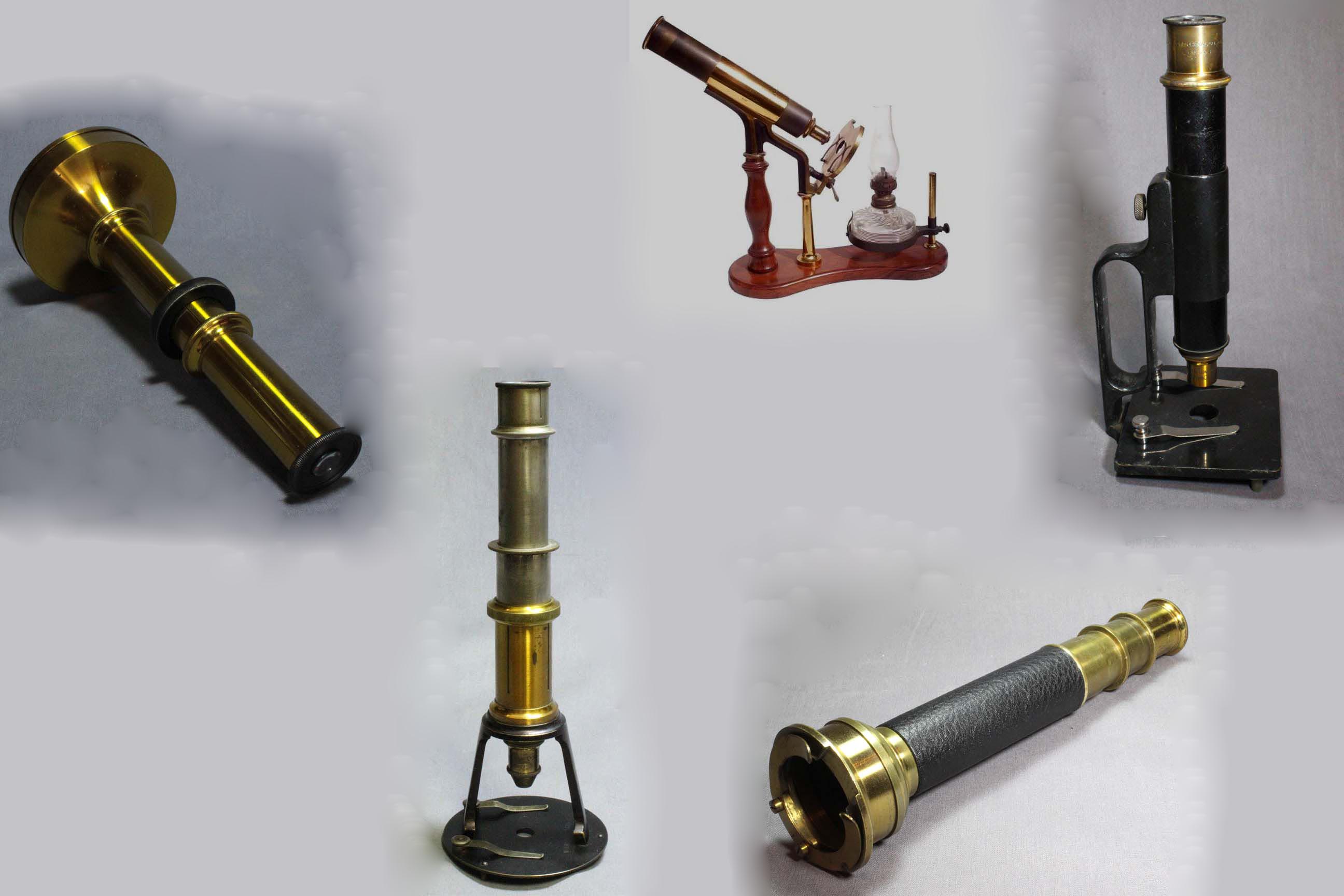
INTRODUCTION:
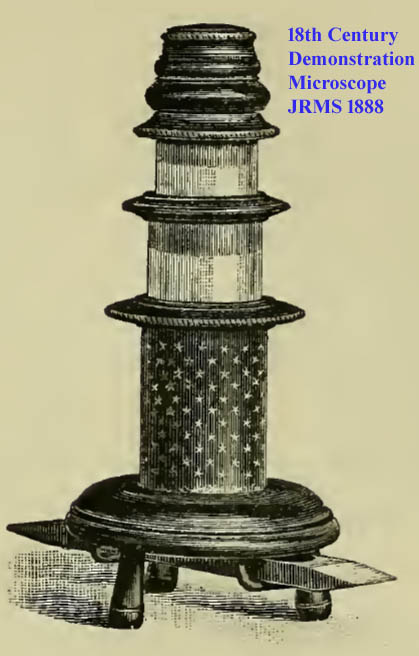 The 'demonstration' or 'school' or 'hand' or 'salon' microscope is a portable microscope which can be passed from person to person for the purpose of viewing the same specimen. Although instruments marketed specifically for this purpose were sold from the middle of the nineteenth century, even Leuwoenhoek's microscopes would qualify as this kind of instrument. In fact, Leuwoenhoek sent microscopes with specimens semi-permanently fixed to them to others just to illustrate his conclusions. He was likely one of the first to do this. Similarly, the Screw Barrel microscope was easily passed from person to person and could be used for this purpose. The microscope shown to the left, from the 1700's, would clearly qualify as a 'Demonstration Microscope' though apparently not marketed as such. This web page discusses many brands and variations of these Demonstration, Classroom or Salon Microscopes. It would be nearly impossible to cover them all, so we have concentrated on the most common examples and some more unusual types, as well as those in our own collections and those of other collectors kind enough to let us use their images.
The 'demonstration' or 'school' or 'hand' or 'salon' microscope is a portable microscope which can be passed from person to person for the purpose of viewing the same specimen. Although instruments marketed specifically for this purpose were sold from the middle of the nineteenth century, even Leuwoenhoek's microscopes would qualify as this kind of instrument. In fact, Leuwoenhoek sent microscopes with specimens semi-permanently fixed to them to others just to illustrate his conclusions. He was likely one of the first to do this. Similarly, the Screw Barrel microscope was easily passed from person to person and could be used for this purpose. The microscope shown to the left, from the 1700's, would clearly qualify as a 'Demonstration Microscope' though apparently not marketed as such. This web page discusses many brands and variations of these Demonstration, Classroom or Salon Microscopes. It would be nearly impossible to cover them all, so we have concentrated on the most common examples and some more unusual types, as well as those in our own collections and those of other collectors kind enough to let us use their images.
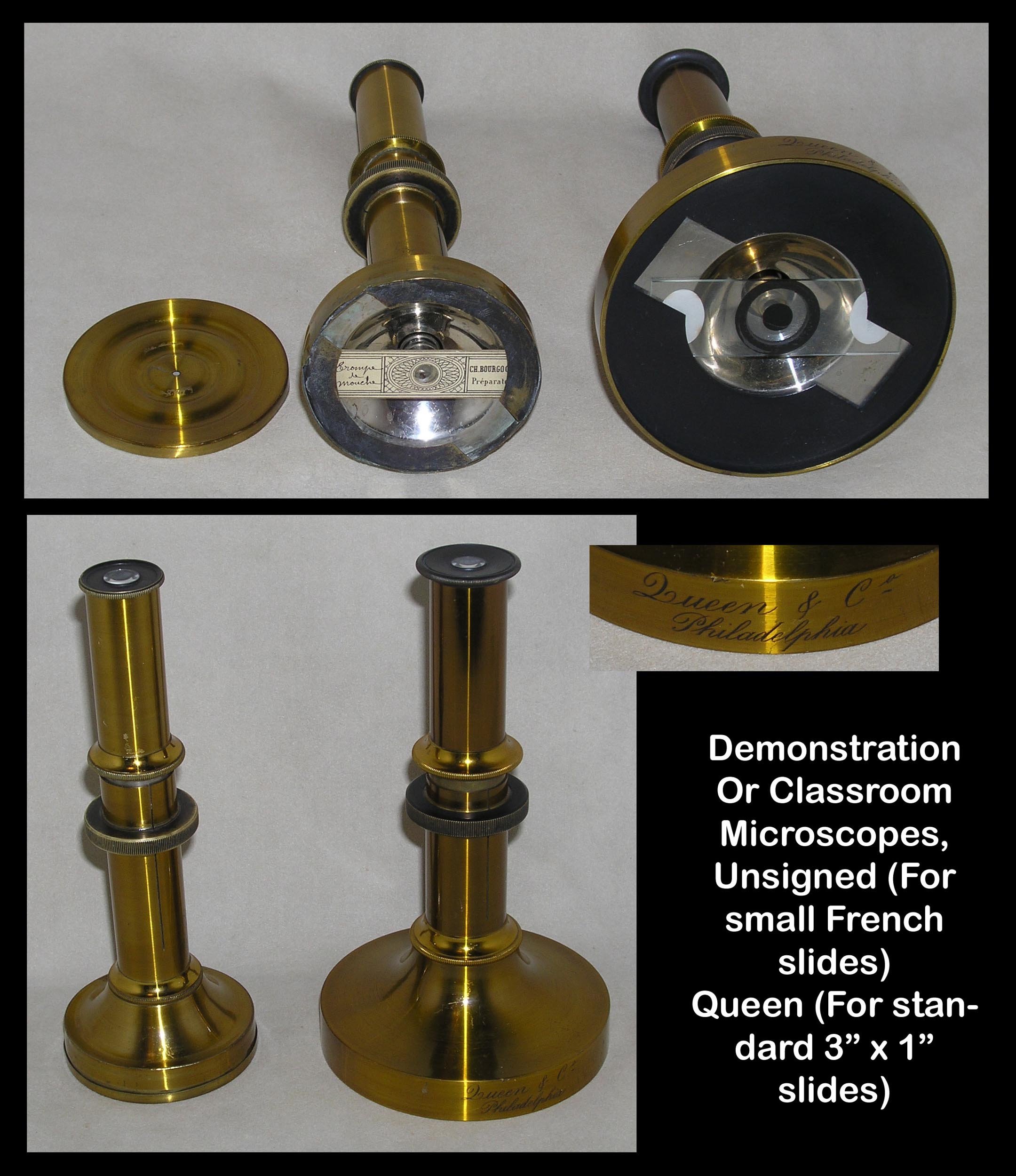
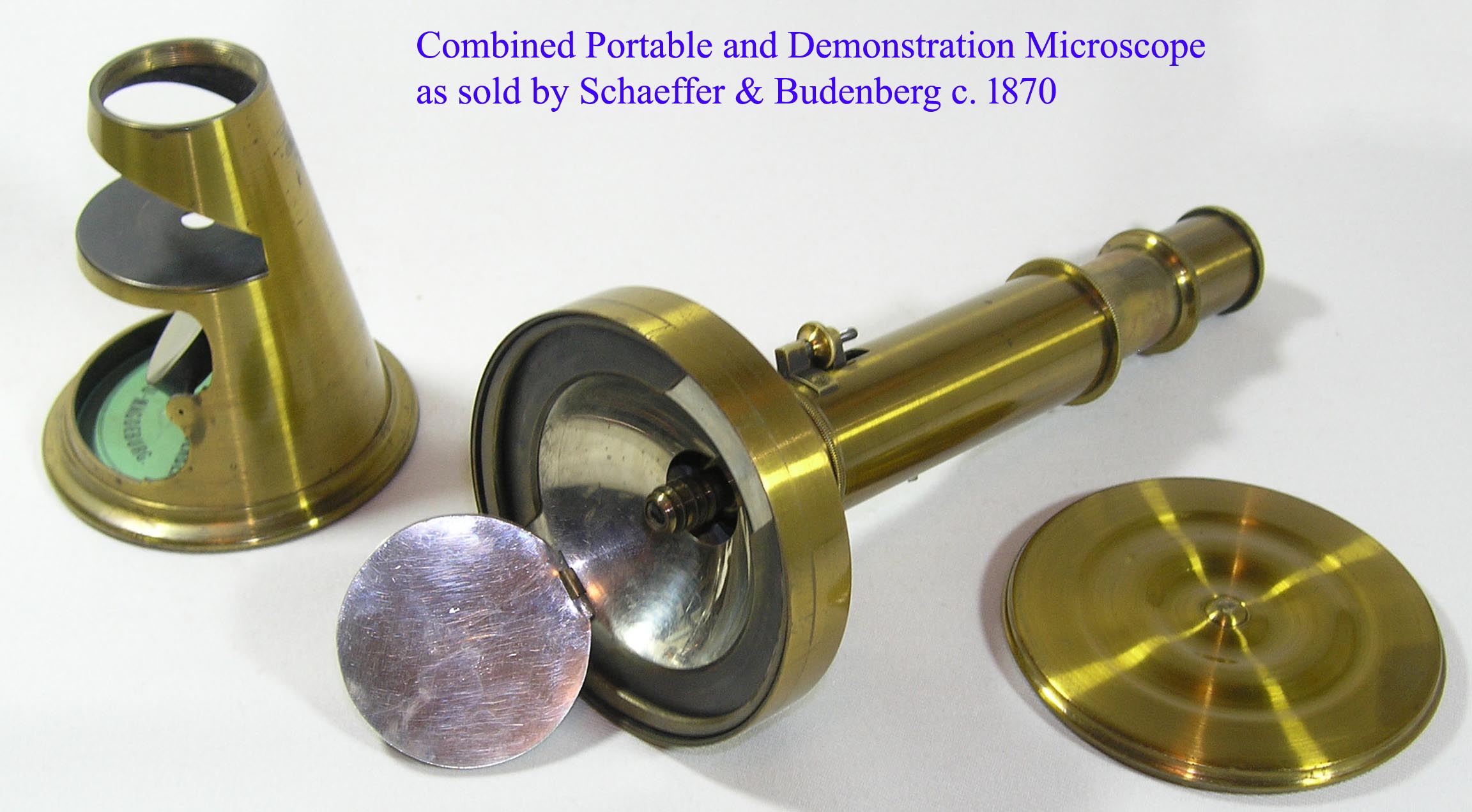
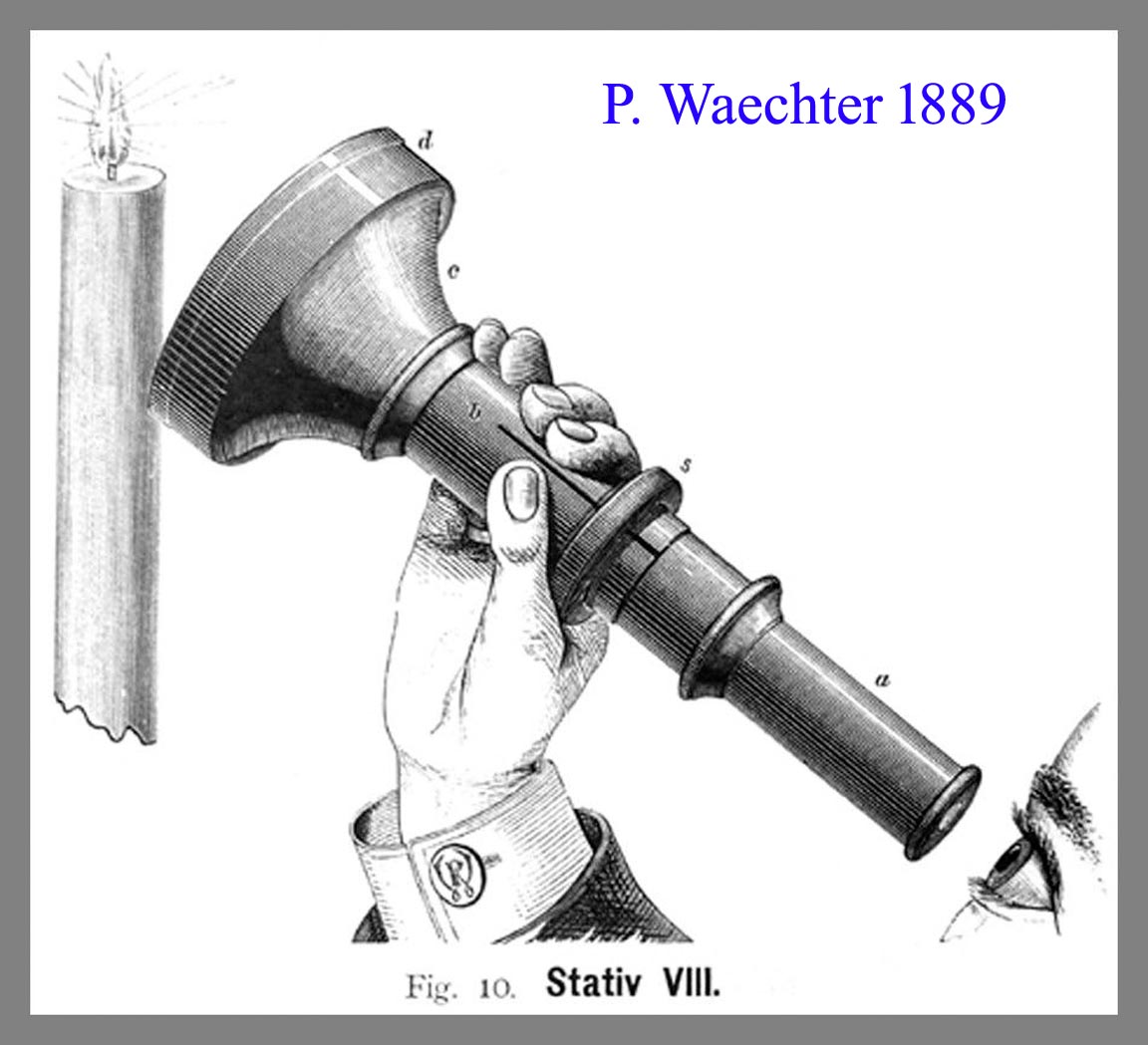 Microscopes specifically marketed for the purpose of being a school or demonstration microscope can be traced to no later than the 1860's. Among the earliest was that invented by the Swiss citizen Conrad von Rappard, which was made by his company, Engell & Company, and subsequently distributed by Schaeffer & Budenberg in Germany. Variations included both a smaller version to accept small slides. as well as the larger one to accept standard 1 x 3 inch slides. These were initially only usable as a handheld instrument, but they were soon marketed with a base to replace the demonstration slide holder so that the instrument could also be used as a portable table microscope. These convertible versions had a fine focus added, in addition to the standard sliding coarse focus. Although the inventor was von Rappard, it is commonly referred to as an 'Engell' microscope. After both Engell & Company and Schaeffer & Budenberg, ceased operations in the 1880's, the production of the Engell Microscope was apparently taken over by Paul Waechter, also in Germany. Sometimes these are referred to as Waechter types, but they were not invented by Waechter. These were exported from Germany and sold in the U.S.A. by Queen & Company with their own signature. Most signed by Queen were likely made by Waechter. Waechter called it their 'Demonstration, School and Salon Microscope' and they numbered it as their 'Stand VIII.'
Microscopes specifically marketed for the purpose of being a school or demonstration microscope can be traced to no later than the 1860's. Among the earliest was that invented by the Swiss citizen Conrad von Rappard, which was made by his company, Engell & Company, and subsequently distributed by Schaeffer & Budenberg in Germany. Variations included both a smaller version to accept small slides. as well as the larger one to accept standard 1 x 3 inch slides. These were initially only usable as a handheld instrument, but they were soon marketed with a base to replace the demonstration slide holder so that the instrument could also be used as a portable table microscope. These convertible versions had a fine focus added, in addition to the standard sliding coarse focus. Although the inventor was von Rappard, it is commonly referred to as an 'Engell' microscope. After both Engell & Company and Schaeffer & Budenberg, ceased operations in the 1880's, the production of the Engell Microscope was apparently taken over by Paul Waechter, also in Germany. Sometimes these are referred to as Waechter types, but they were not invented by Waechter. These were exported from Germany and sold in the U.S.A. by Queen & Company with their own signature. Most signed by Queen were likely made by Waechter. Waechter called it their 'Demonstration, School and Salon Microscope' and they numbered it as their 'Stand VIII.'
 Another form marketed as a demonstration microscope was invented by Lionel Beale, also about 1860. One of the earliest forms was sold by William Mathews in England. Its coarse focus was fixed by a system of a sprung peg fitting into holes. According to Dr Beale, various 'improved' forms of it were sold by Baker, Moginie, Hawksley, and Swift. Most of these had a locking ring to fix the coarse focus, though there were some made without a locking mechanism.
Another form marketed as a demonstration microscope was invented by Lionel Beale, also about 1860. One of the earliest forms was sold by William Mathews in England. Its coarse focus was fixed by a system of a sprung peg fitting into holes. According to Dr Beale, various 'improved' forms of it were sold by Baker, Moginie, Hawksley, and Swift. Most of these had a locking ring to fix the coarse focus, though there were some made without a locking mechanism.
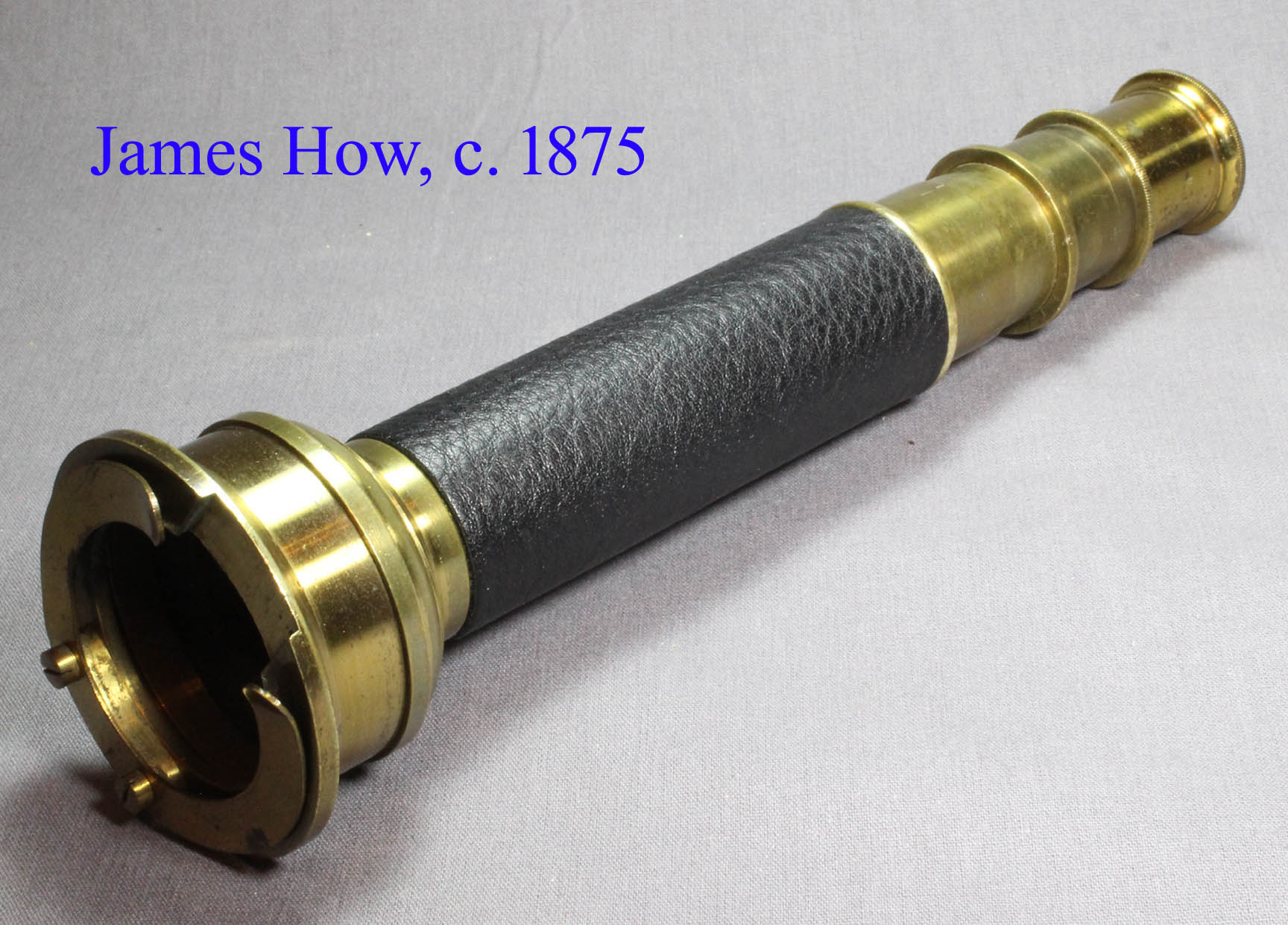
The James How example in this collection has no locking mechanism. We also know Beale types were made by others, including Samuel Highley, and Charles Collins.
Variations of the Beale microscope:
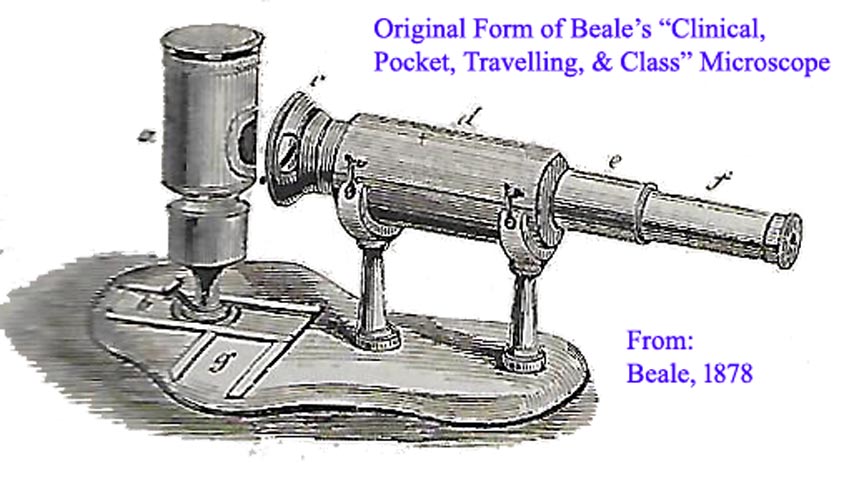
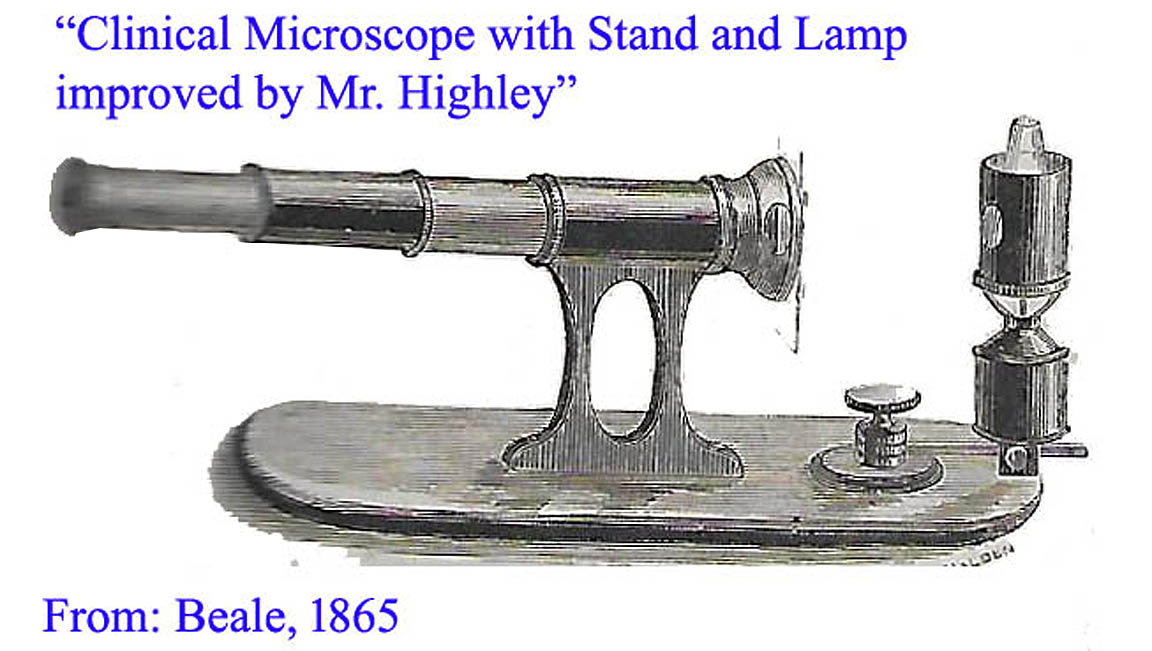 When held alone, the Beale microscope was sometimes called the 'Beale Clinical Microscope'. A variation with the microscope fixed in the horizontal position on a wood base with kerosene lamp at the end of the base was marketed specifically as the 'Beale Demonstration Microscope'. The earlier form(left) had an attachement of the microscope to the base by brass catches. The 'improved model' by Highley(right) was more robust with the microscope attached to the base in a much more secure fashion.
When held alone, the Beale microscope was sometimes called the 'Beale Clinical Microscope'. A variation with the microscope fixed in the horizontal position on a wood base with kerosene lamp at the end of the base was marketed specifically as the 'Beale Demonstration Microscope'. The earlier form(left) had an attachement of the microscope to the base by brass catches. The 'improved model' by Highley(right) was more robust with the microscope attached to the base in a much more secure fashion.
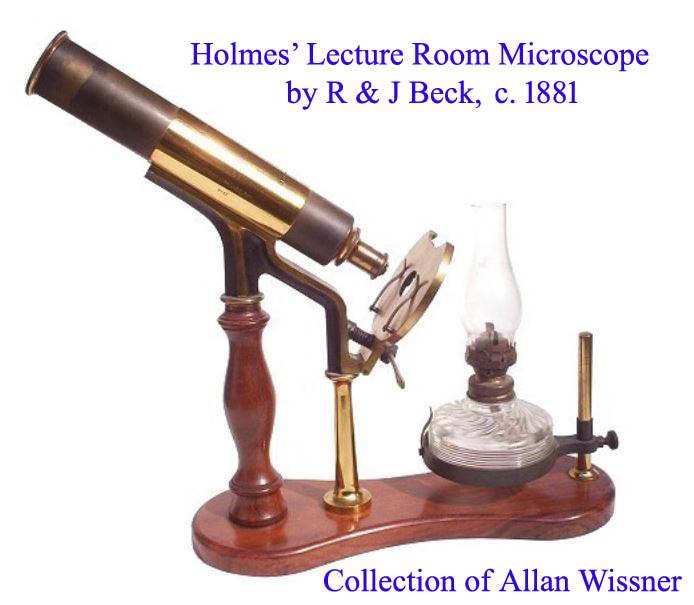 Oliver Wendall Holmes Sr, the father of the famous Judge, was a famous American physician, poet, and inventor in his own right. He designed a modification of the horizontally-oriented Beale demonstration microscope with an inclined body and tilting stage fine focus. This instrument, made by Beck, and referred to in the 1882 Beck catalog as the 'Holmes Lecture Room Microscope' improved its convenience in use, and allowed it to be used easily even while it was placed on a table or desk. The tilting stage fine focus was controlled by a lever attached to a screw and opposed by a spring to prevent any play in the mechanism. This microscope was described and pictured in the JRMS of 1881. An example said to Holmes own instrument, made by R & J Beck, can be seen at the Harvard collection.
Oliver Wendall Holmes Sr, the father of the famous Judge, was a famous American physician, poet, and inventor in his own right. He designed a modification of the horizontally-oriented Beale demonstration microscope with an inclined body and tilting stage fine focus. This instrument, made by Beck, and referred to in the 1882 Beck catalog as the 'Holmes Lecture Room Microscope' improved its convenience in use, and allowed it to be used easily even while it was placed on a table or desk. The tilting stage fine focus was controlled by a lever attached to a screw and opposed by a spring to prevent any play in the mechanism. This microscope was described and pictured in the JRMS of 1881. An example said to Holmes own instrument, made by R & J Beck, can be seen at the Harvard collection.
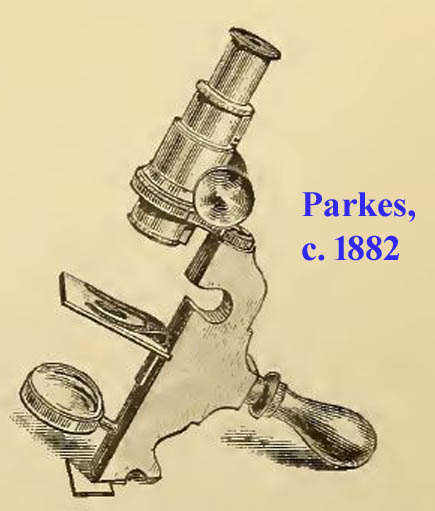 Parkes 'Class Microscope' was reported in the 1882 volume of the JRMS, but was listed in the Parkes catalog as early as 1862.. It makes use of the simple but sound concept of an optical bench were all components are mounted on a straight wooden limb. It would be used as a small portable microscope support on a table as shown with a mirror instead of the usual condenser used for demonstration purposes.
Parkes 'Class Microscope' was reported in the 1882 volume of the JRMS, but was listed in the Parkes catalog as early as 1862.. It makes use of the simple but sound concept of an optical bench were all components are mounted on a straight wooden limb. It would be used as a small portable microscope support on a table as shown with a mirror instead of the usual condenser used for demonstration purposes.
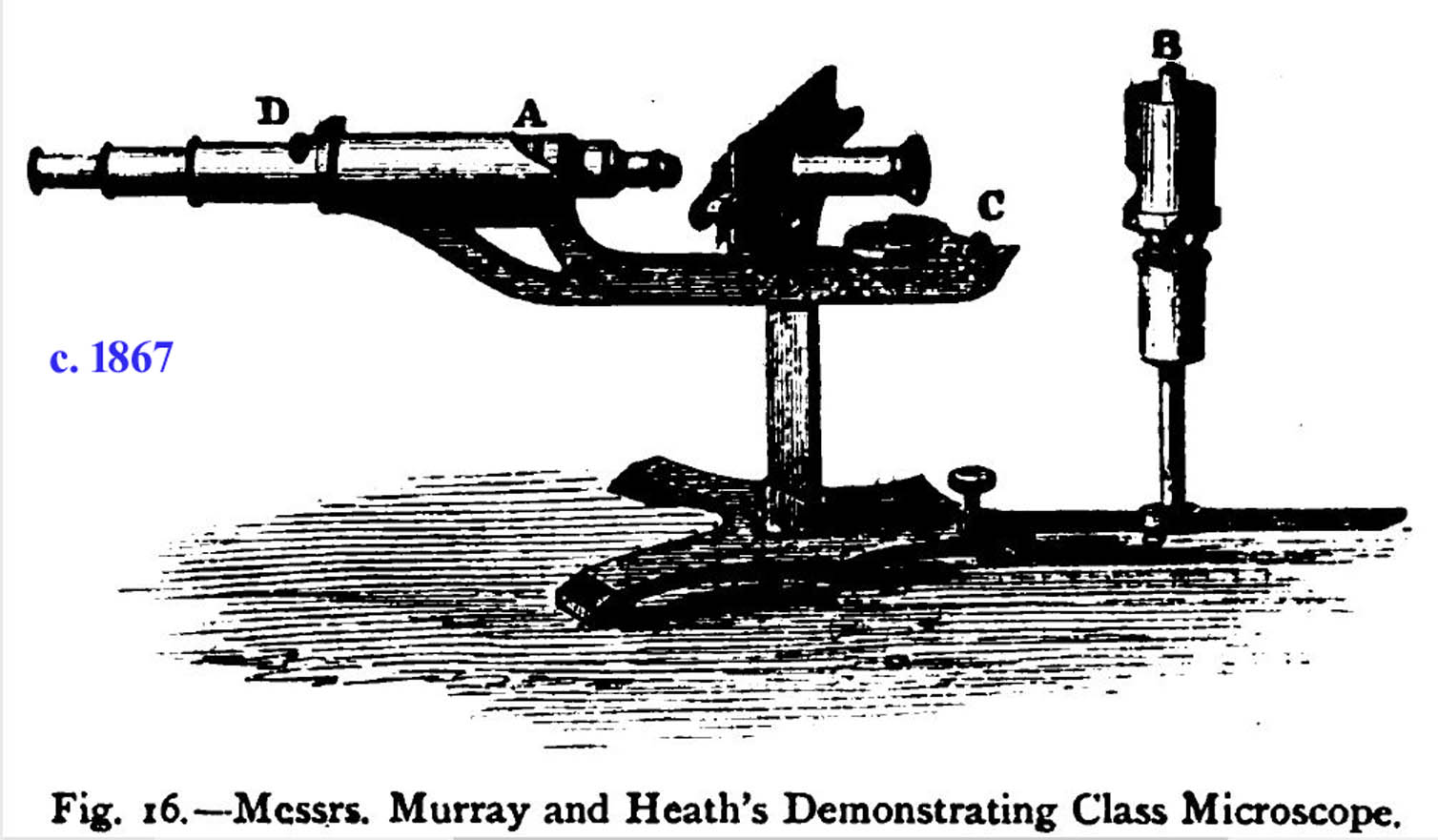 This is Murray & Heath's version of a Classroom Demonstration Microscope, as illustrated in Foster's Report of 1867. It allows the locking of the coarse focus, with fine focus achieved by a secondary draw tube. Note the substage condenser, and the built-in miniature illumination lamp.
This is Murray & Heath's version of a Classroom Demonstration Microscope, as illustrated in Foster's Report of 1867. It allows the locking of the coarse focus, with fine focus achieved by a secondary draw tube. Note the substage condenser, and the built-in miniature illumination lamp.
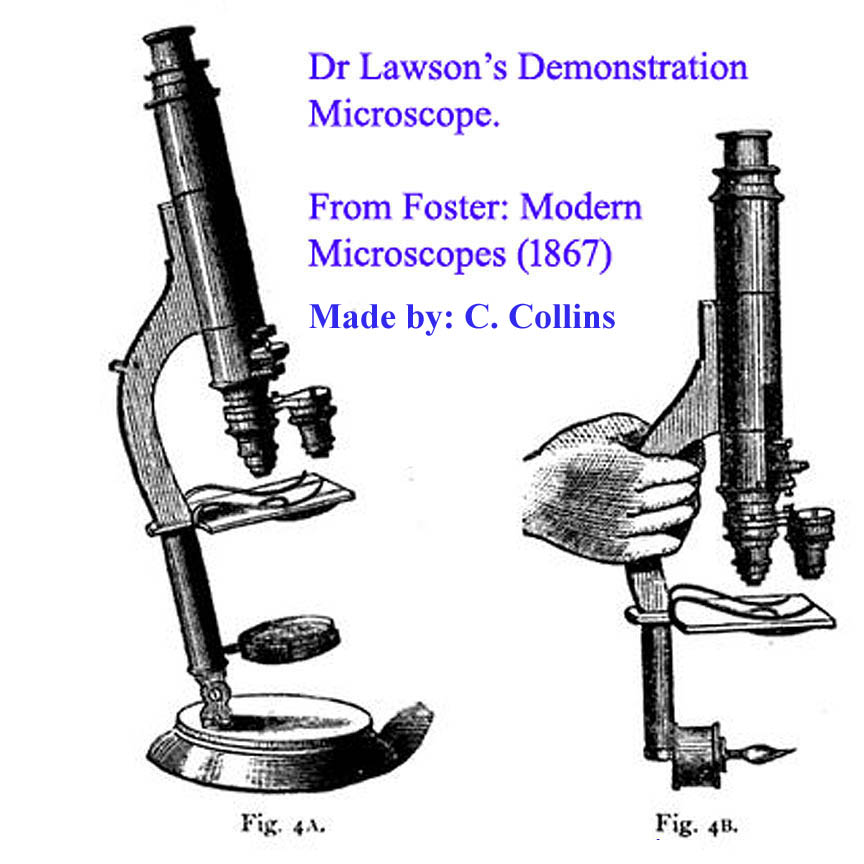 Also reported in Foster's Report of 1867, this is 'Dr Lawson's' design for a demonstration and table-top portable microscope as made by Charles Collins starting from, or before, 1867. It featured sliding tube coarse focusing and short lever fine focusing from the nosepiece. It detached from its base for handheld use and apparently also had provision for a miniature lamp as a light source. The limb serves as its handle.
Also reported in Foster's Report of 1867, this is 'Dr Lawson's' design for a demonstration and table-top portable microscope as made by Charles Collins starting from, or before, 1867. It featured sliding tube coarse focusing and short lever fine focusing from the nosepiece. It detached from its base for handheld use and apparently also had provision for a miniature lamp as a light source. The limb serves as its handle.
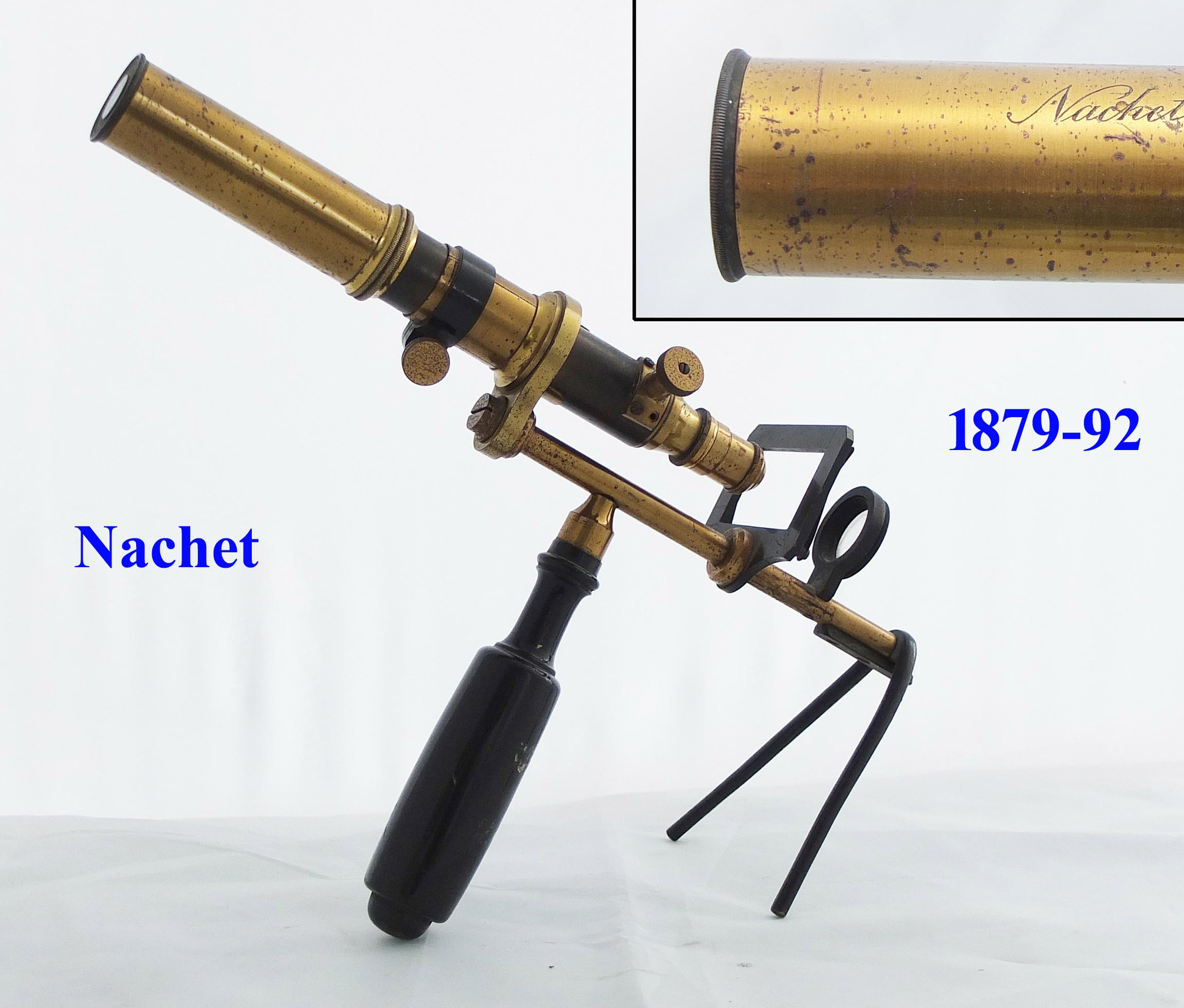
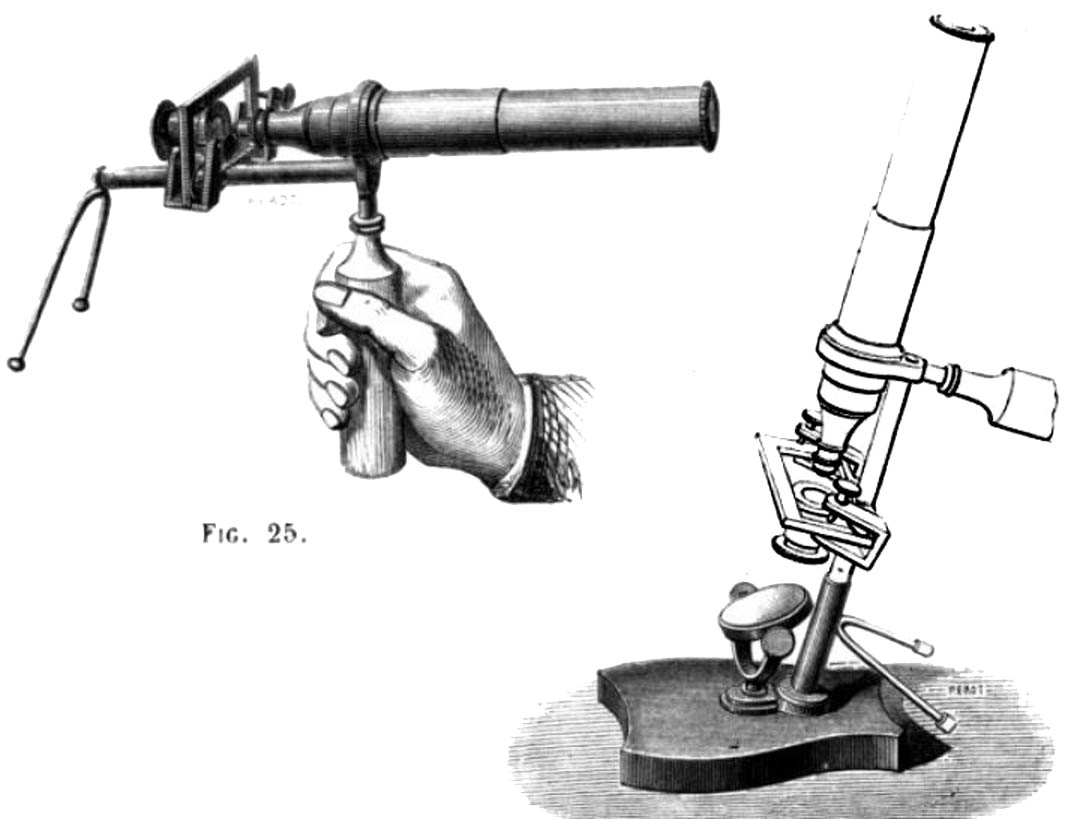 Nachet of Paris made demonstration microscopes starting about 1872, and their first model, 'Microscope de demonstation a la main' was easily converted from a lightweight portable model to a handheld demonstation model and vice-versa by simply fitting onto a simple stand made for the purpose. It was first reported in the JRMS in 1879. This model was pictured in catalogs through 1892. It is curious that despite being offered for at least 20 years, this model is seldom seen today; one explanation may be that it is constructed with rather thin parts, which although made it conveniently light, meant it would probably not stand up well to repeated use in a classroom. There was apparently no demonstration microscope shown in Nachet catalogs after 1892 until 1910 when a new model was apparently first introduced. This new model was the 'Microscope a main pour demonstration dans les cours' and was a much more substantial continental model which could be detached from its upright on the horseshoe foot(see entry below).
Nachet of Paris made demonstration microscopes starting about 1872, and their first model, 'Microscope de demonstation a la main' was easily converted from a lightweight portable model to a handheld demonstation model and vice-versa by simply fitting onto a simple stand made for the purpose. It was first reported in the JRMS in 1879. This model was pictured in catalogs through 1892. It is curious that despite being offered for at least 20 years, this model is seldom seen today; one explanation may be that it is constructed with rather thin parts, which although made it conveniently light, meant it would probably not stand up well to repeated use in a classroom. There was apparently no demonstration microscope shown in Nachet catalogs after 1892 until 1910 when a new model was apparently first introduced. This new model was the 'Microscope a main pour demonstration dans les cours' and was a much more substantial continental model which could be detached from its upright on the horseshoe foot(see entry below).
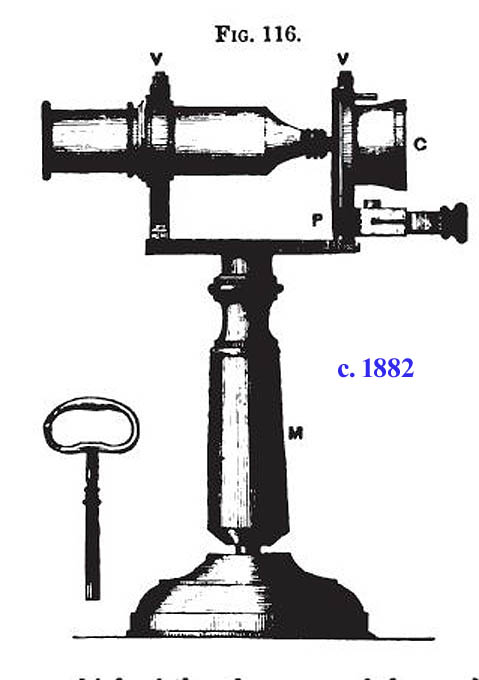 The microscope shown here, available no later than 1882, was invented by the Parisian professor A. Guillemare. Its distinctive features included locking screws for the focus of the optical tube and also the slide, providing a more reliable way of illustrating a specific feature of a specimen. It was also provided with the convenience of a built-in stand.
The microscope shown here, available no later than 1882, was invented by the Parisian professor A. Guillemare. Its distinctive features included locking screws for the focus of the optical tube and also the slide, providing a more reliable way of illustrating a specific feature of a specimen. It was also provided with the convenience of a built-in stand.
 The demonstration microscope of Hartnack of 1882 would also stand on its own. It consisted of a frame attached to a drum type base. The base had two improvements over some other examples, namely an adjustible wheel of apertures, and a substage condensing lens.
The demonstration microscope of Hartnack of 1882 would also stand on its own. It consisted of a frame attached to a drum type base. The base had two improvements over some other examples, namely an adjustible wheel of apertures, and a substage condensing lens.
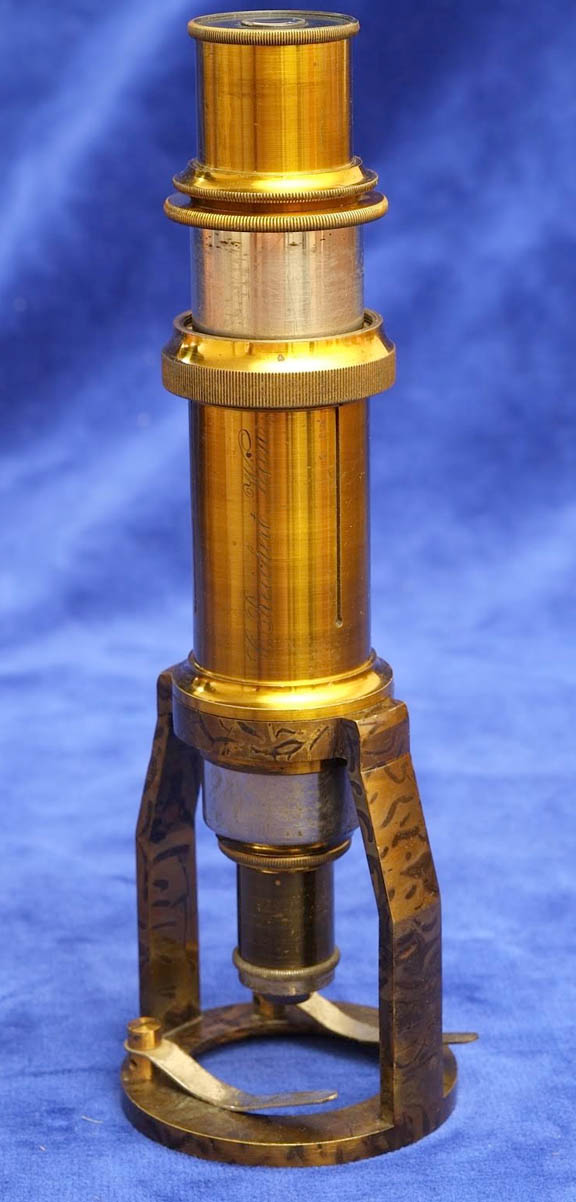
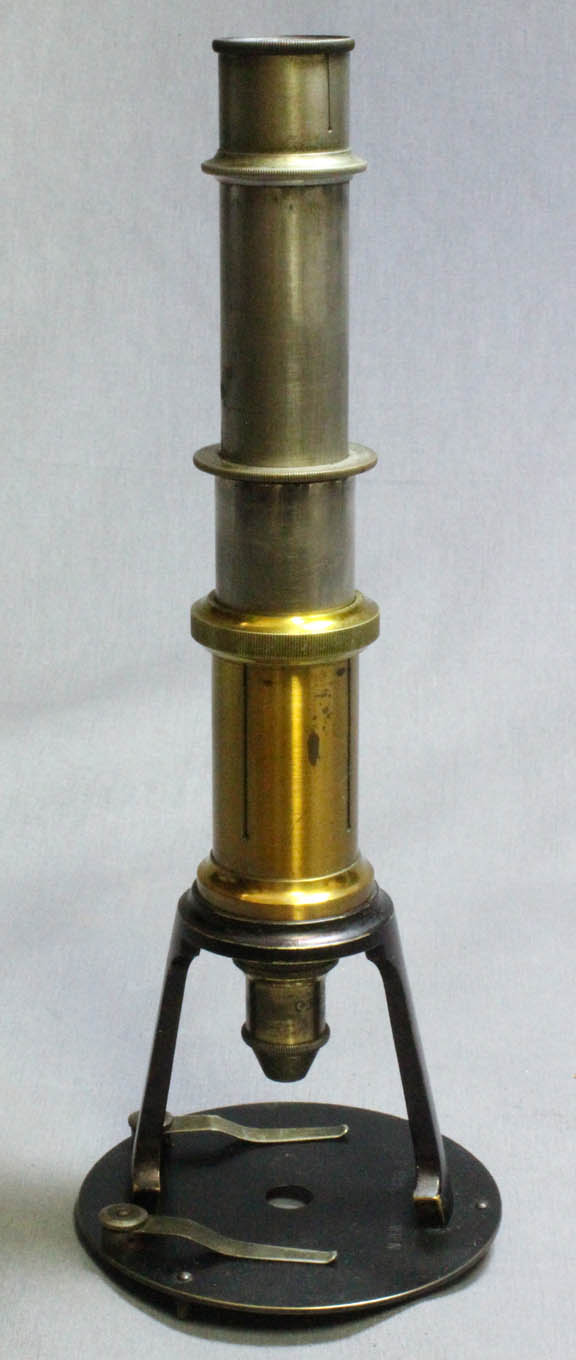 Shown to the left is a Reichert Demonstration microscope offered in their catalog as early as 1883 through the 1890s. It predated the very similar Leitz model shown below as illustrated in the JRMS of 1888. This microscope has very short legs under the stage. The image to the right is another Reichert Demo scope bearing an even greater resemblance to the Leitz model.
Shown to the left is a Reichert Demonstration microscope offered in their catalog as early as 1883 through the 1890s. It predated the very similar Leitz model shown below as illustrated in the JRMS of 1888. This microscope has very short legs under the stage. The image to the right is another Reichert Demo scope bearing an even greater resemblance to the Leitz model.
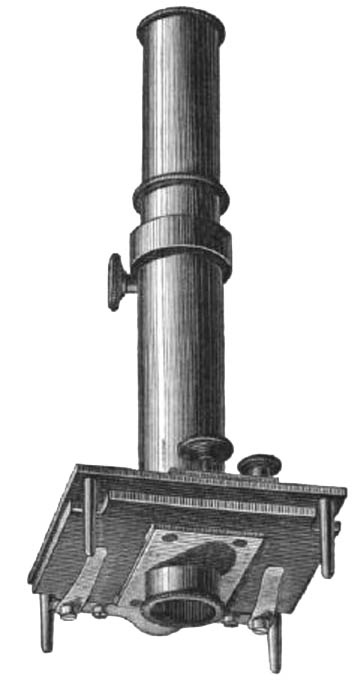 The Klonne & Muller Demonstration Microscope, described in the JRMS of 1883 provided a locking coarse focus, and a tilting stage fine focus. It incorporated four legs to support it when not in use. Although the RMS article states that the slide was held on the bottom plate by the stage clips, the illustration shows a condenser housing in that location, thus it is unclear how this arrangement could be used, if the description is accurate.
The Klonne & Muller Demonstration Microscope, described in the JRMS of 1883 provided a locking coarse focus, and a tilting stage fine focus. It incorporated four legs to support it when not in use. Although the RMS article states that the slide was held on the bottom plate by the stage clips, the illustration shows a condenser housing in that location, thus it is unclear how this arrangement could be used, if the description is accurate.
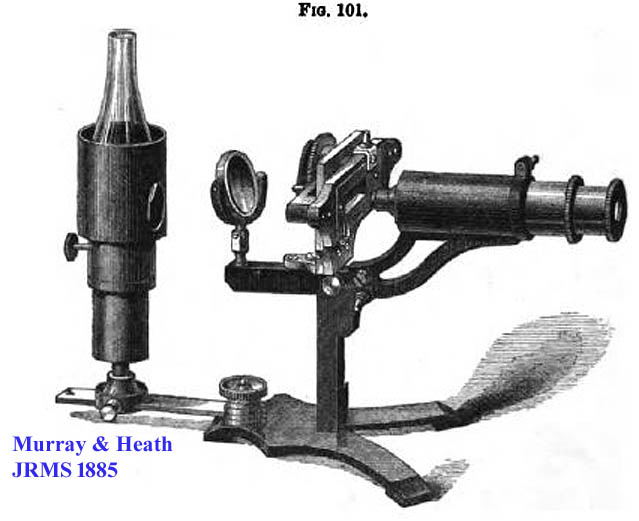 Reported in the JRMS of 1885, Murray & Heath's Class Demonstration microscope, earlier noted in Foster in 1865, now incorporated locking mechanisms to lock the slide in place, lock the slide's position on the stage, lock the inclination joint, and lock the coarse focus. Note the built-in light source, introduced with the 1860s model.
Reported in the JRMS of 1885, Murray & Heath's Class Demonstration microscope, earlier noted in Foster in 1865, now incorporated locking mechanisms to lock the slide in place, lock the slide's position on the stage, lock the inclination joint, and lock the coarse focus. Note the built-in light source, introduced with the 1860s model.
 The Winkel Demonstration microscope of 1885 had the advantage of a simple under-the-stage mechanism to readily reposition the slide.
The Winkel Demonstration microscope of 1885 had the advantage of a simple under-the-stage mechanism to readily reposition the slide.
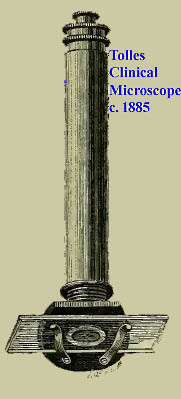 The famous Robert B. Tolles produced this simplified demonstration microscope which was reported in the JRMS of 1885. Coarse focus was by sliding the inner tube and fine by twisting the entire optical tube assembly.
The famous Robert B. Tolles produced this simplified demonstration microscope which was reported in the JRMS of 1885. Coarse focus was by sliding the inner tube and fine by twisting the entire optical tube assembly.
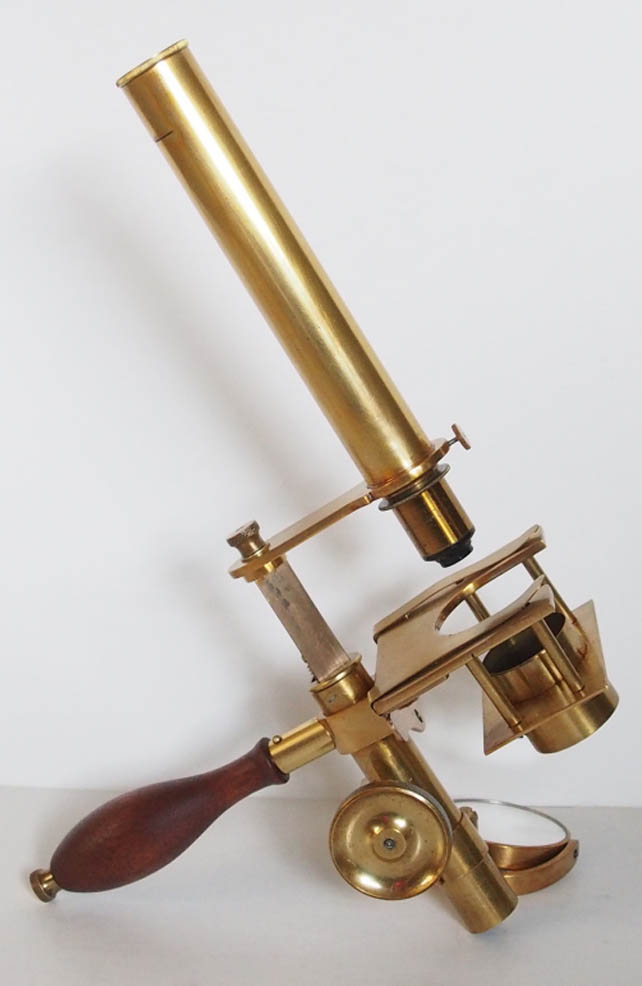 The Nelson Portable and Field microscope, otherwise known as the 'Jubilee' Microscope, was made by Powell & Lealand to the design of E.M. Nelson and first reported in late 1887 in the JRMS. Like the Nachet model it was designed as a portable desk top model or as a field or demonstration microscope. Just like the Nachet, after being detached from its stand, a wooden handle would be screwed on to convert it to the demonstration mode.
The Nelson Portable and Field microscope, otherwise known as the 'Jubilee' Microscope, was made by Powell & Lealand to the design of E.M. Nelson and first reported in late 1887 in the JRMS. Like the Nachet model it was designed as a portable desk top model or as a field or demonstration microscope. Just like the Nachet, after being detached from its stand, a wooden handle would be screwed on to convert it to the demonstration mode.
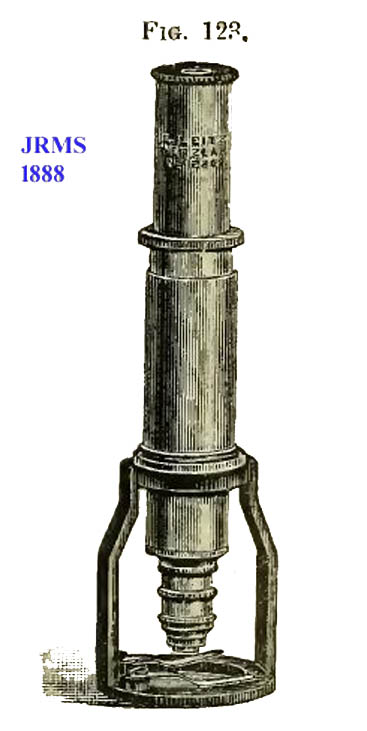 The German firm of Ernst Leitz produced several variations of demonstration microscopes over the years. Their model reported in the JRMS of 1888 was apparently a copy of the earlier Reichert version, and simply consisted of a flat stage with two supports to the sleeve for the sliding focus optical tube.
The German firm of Ernst Leitz produced several variations of demonstration microscopes over the years. Their model reported in the JRMS of 1888 was apparently a copy of the earlier Reichert version, and simply consisted of a flat stage with two supports to the sleeve for the sliding focus optical tube.
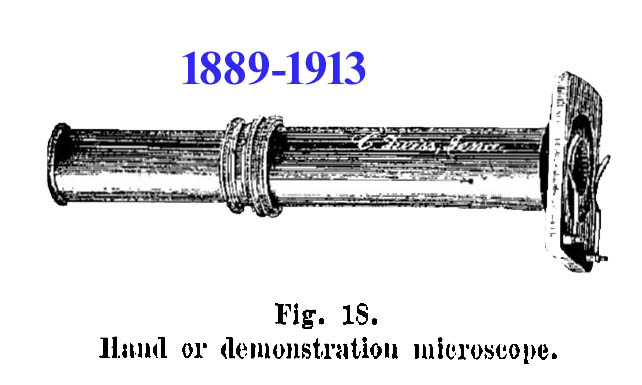 This basic form of Zeiss 'Hand Microscope' was offered in the Zeiss catalogs from no later than 1893 through at least 1913.
This basic form of Zeiss 'Hand Microscope' was offered in the Zeiss catalogs from no later than 1893 through at least 1913.
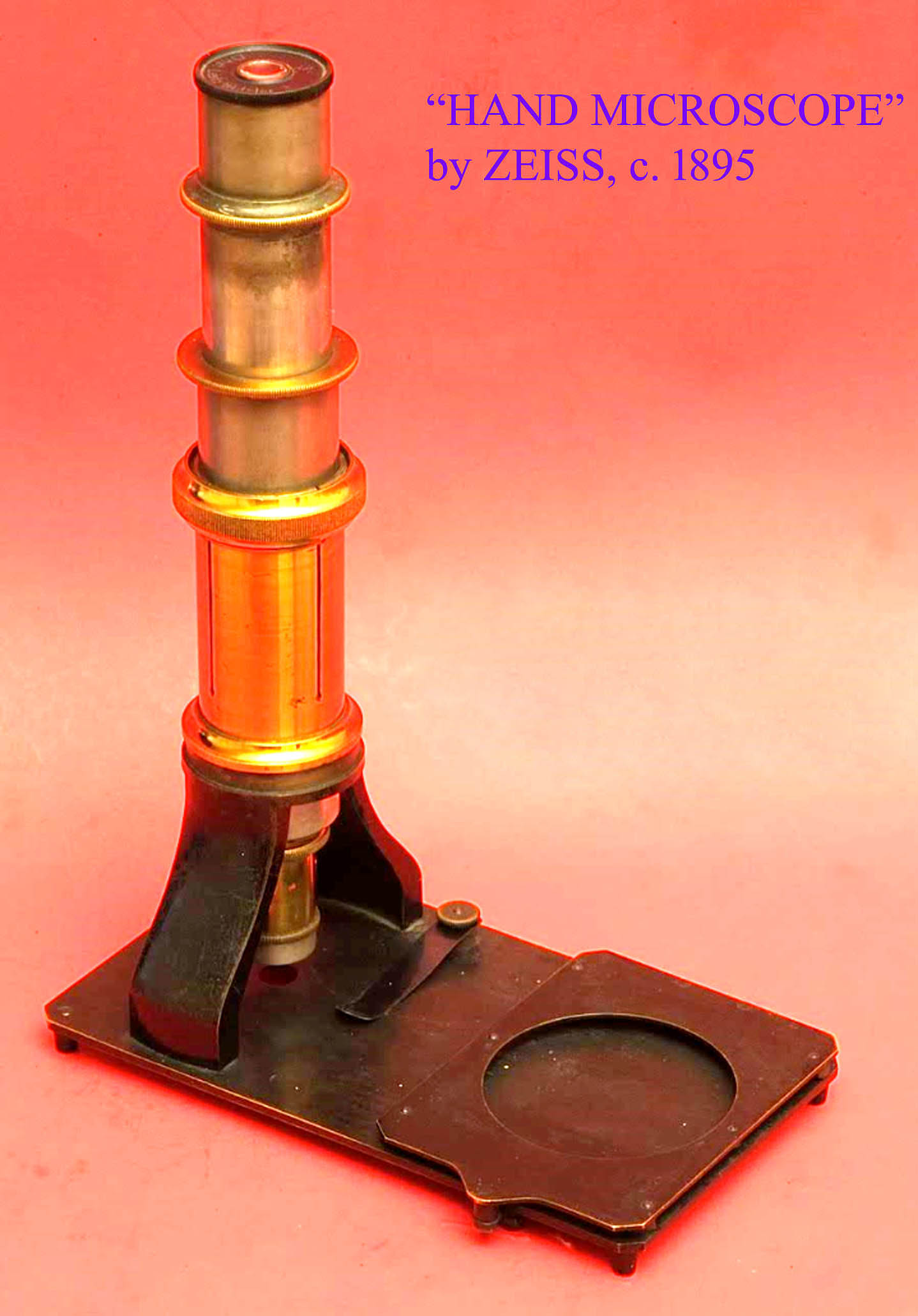 This Zeiss 'Hand microscope' provides an extension of the stage with a frame to hold a comparison image of the subject seen on the slide. It is almost identical to the Reichert version reported in the JRMS of 1893, so likely a copy of the Reichert original. The only difference is that the pieces supporting the microscope tube are in front and back in this one, vs right and left on the Reichert model.
This Zeiss 'Hand microscope' provides an extension of the stage with a frame to hold a comparison image of the subject seen on the slide. It is almost identical to the Reichert version reported in the JRMS of 1893, so likely a copy of the Reichert original. The only difference is that the pieces supporting the microscope tube are in front and back in this one, vs right and left on the Reichert model.
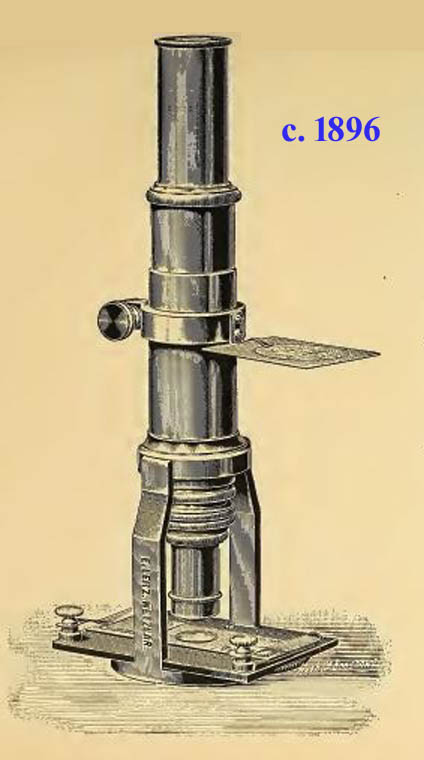 By 1896, Leitz's Demonstration microscope was offered with a substage wheel of apertures, a 'clip to hold a sketch or label', and a clamp to fix the coarse focus, all standard. Options included fine focus and substage condenser.
By 1896, Leitz's Demonstration microscope was offered with a substage wheel of apertures, a 'clip to hold a sketch or label', and a clamp to fix the coarse focus, all standard. Options included fine focus and substage condenser.
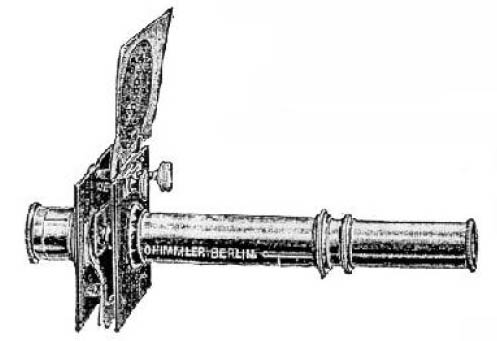 This is an illustration of the 1903 Kolkowitz Demonstration Microscope as made by Otto Himler of Germany. Note that this microscope also has provision for attaching a matching illustration to assist the user in identifying what they were seeing under the microscope, and that it is shown with a substage condenser.
This is an illustration of the 1903 Kolkowitz Demonstration Microscope as made by Otto Himler of Germany. Note that this microscope also has provision for attaching a matching illustration to assist the user in identifying what they were seeing under the microscope, and that it is shown with a substage condenser.
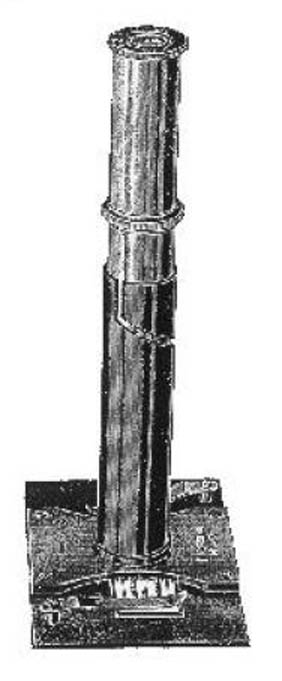 This microscope by Koritska from about 1903, has an hourglass-shaped plate mounted above the square stage with space between the top of the stage and the bottom of this plate to accomodate a slide held in place by two stage clips. Focusing is via a twisting pin in groove mechanism.
This microscope by Koritska from about 1903, has an hourglass-shaped plate mounted above the square stage with space between the top of the stage and the bottom of this plate to accomodate a slide held in place by two stage clips. Focusing is via a twisting pin in groove mechanism.
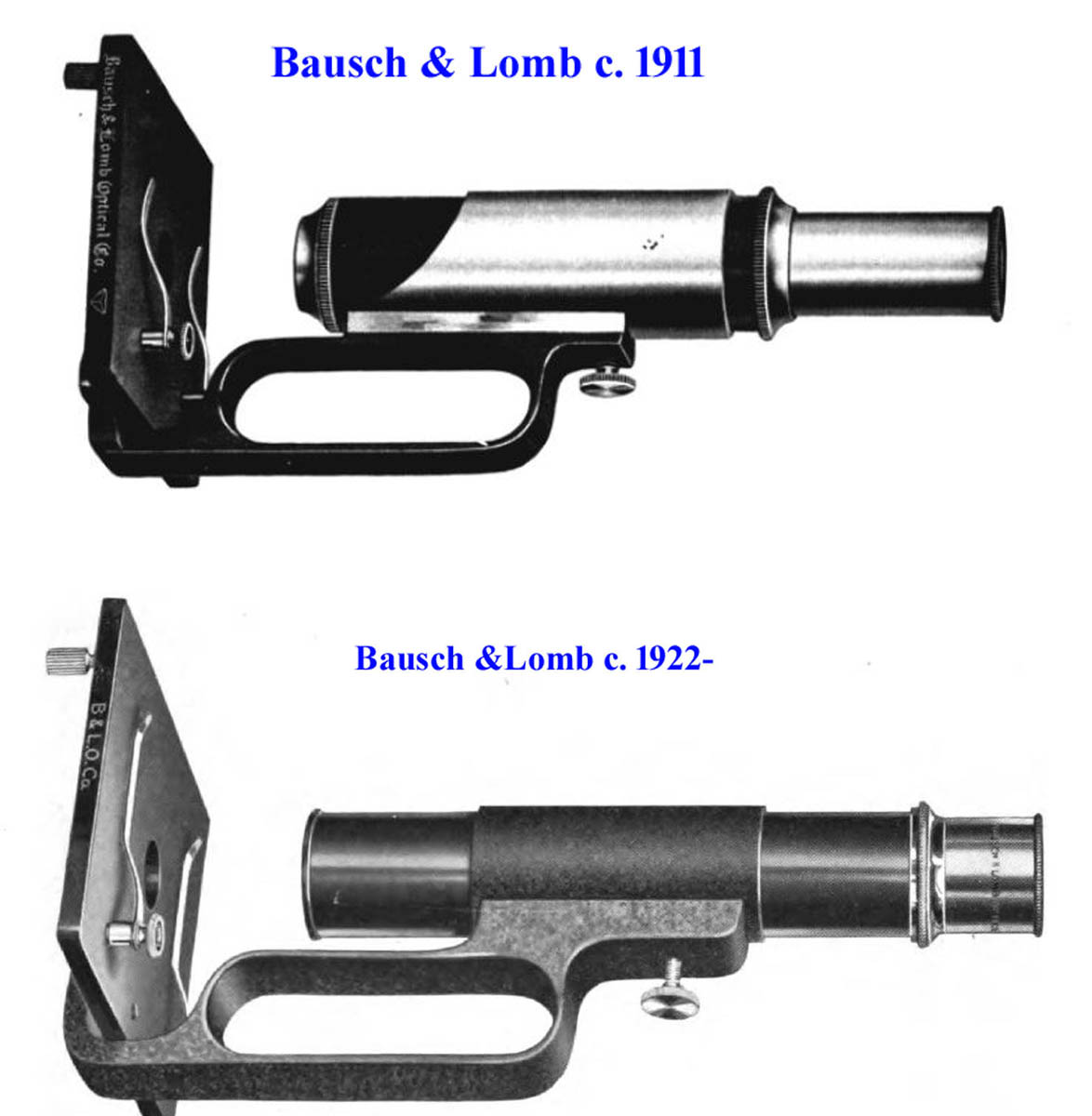
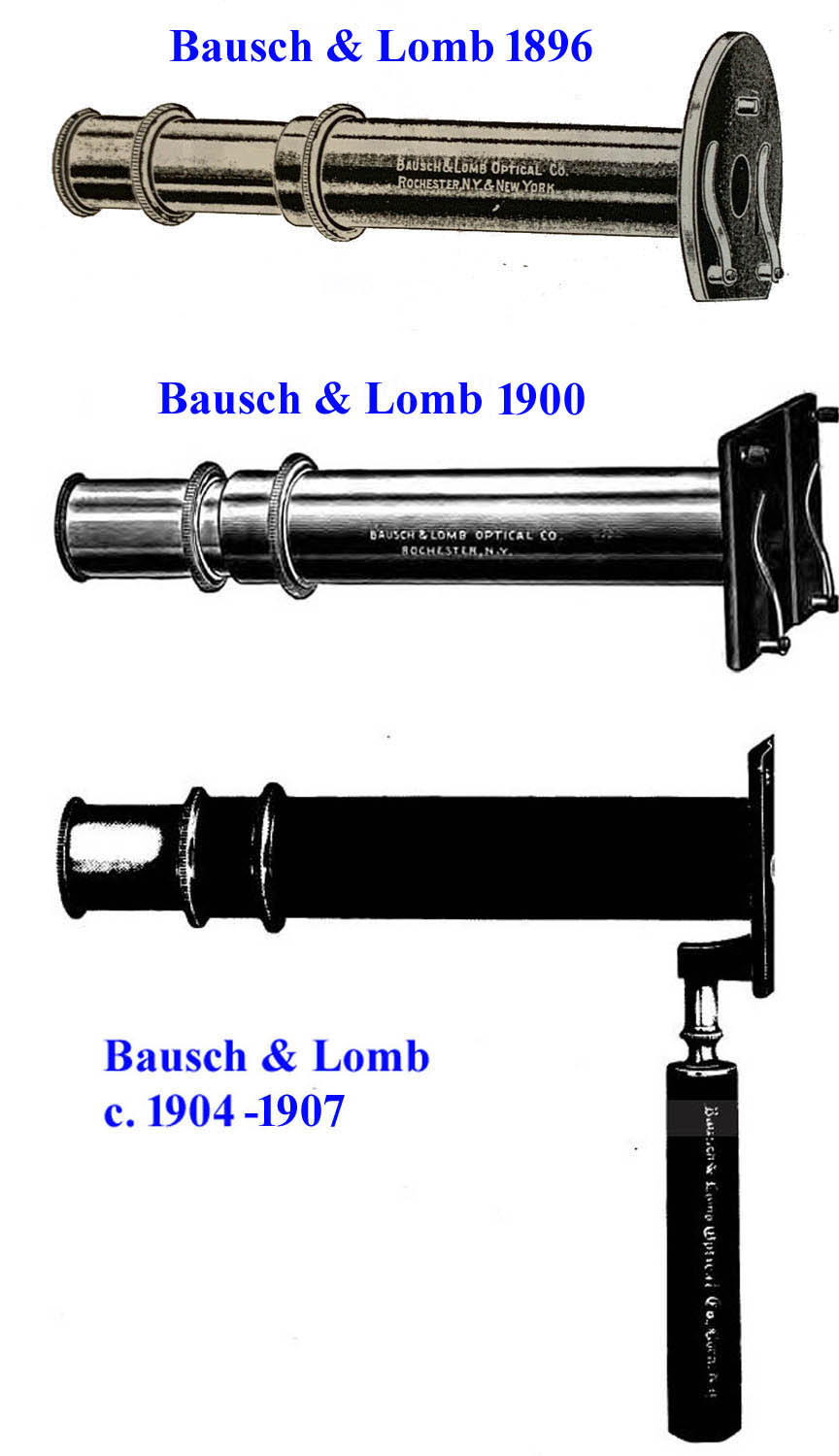 Bausch & Lomb apparently started to manufacture demonstration microscopes about 1895 and these evolved over the years. The early models, as shown by the 1896 model, were similar to the 1889 model of Zeiss(and others) in that it was simply a focusing tube attached to a plate supporting a slide. By 1904 a handle was added, and by 1911 it looked more like a microscope with a 'jug handle'. Variations of the jug handle continued through at least 1922. The only drawback still present in the 1922 model, was that the slide was held in place by stage clips and so as it was passed from student to student, the slide was likely to move unless taped in place.
Bausch & Lomb apparently started to manufacture demonstration microscopes about 1895 and these evolved over the years. The early models, as shown by the 1896 model, were similar to the 1889 model of Zeiss(and others) in that it was simply a focusing tube attached to a plate supporting a slide. By 1904 a handle was added, and by 1911 it looked more like a microscope with a 'jug handle'. Variations of the jug handle continued through at least 1922. The only drawback still present in the 1922 model, was that the slide was held in place by stage clips and so as it was passed from student to student, the slide was likely to move unless taped in place.
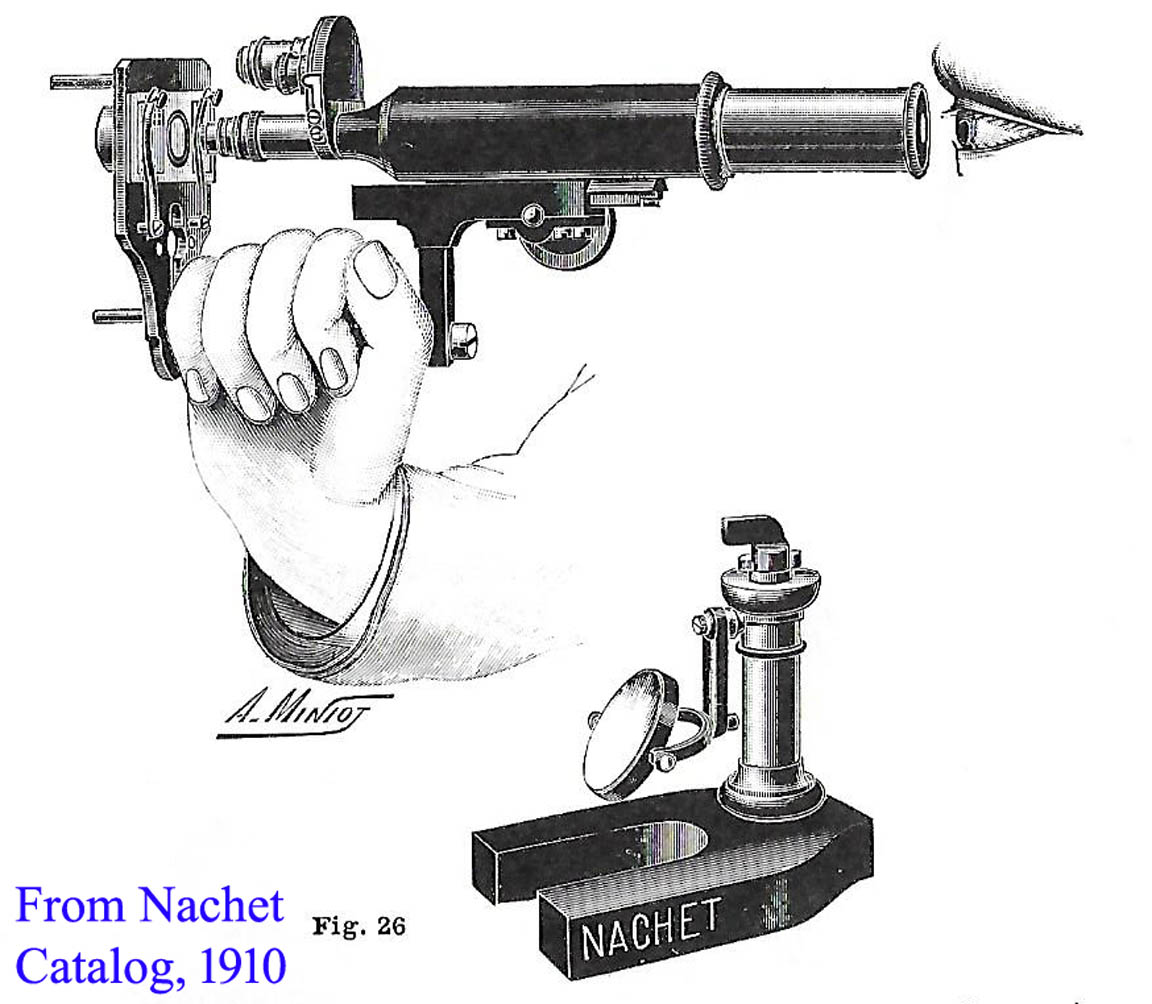 The 'Microscope a main pour demonstration dans les cours,' first introduced in the 1910 Nachet catalog, was a portable continental model which could easily and quickly be detached from its upright on the horseshoe foot, and held by its limb, becomming a demonstration microscope. This idea of detaching from the upright of the foot at the level of the stage was not invented by Nachet, having been developed by Sidle and others, many years earlier. As noted above this is a much more rigid stand, likely to stand up to more use than the prior Nachet demonstration model.
The 'Microscope a main pour demonstration dans les cours,' first introduced in the 1910 Nachet catalog, was a portable continental model which could easily and quickly be detached from its upright on the horseshoe foot, and held by its limb, becomming a demonstration microscope. This idea of detaching from the upright of the foot at the level of the stage was not invented by Nachet, having been developed by Sidle and others, many years earlier. As noted above this is a much more rigid stand, likely to stand up to more use than the prior Nachet demonstration model.
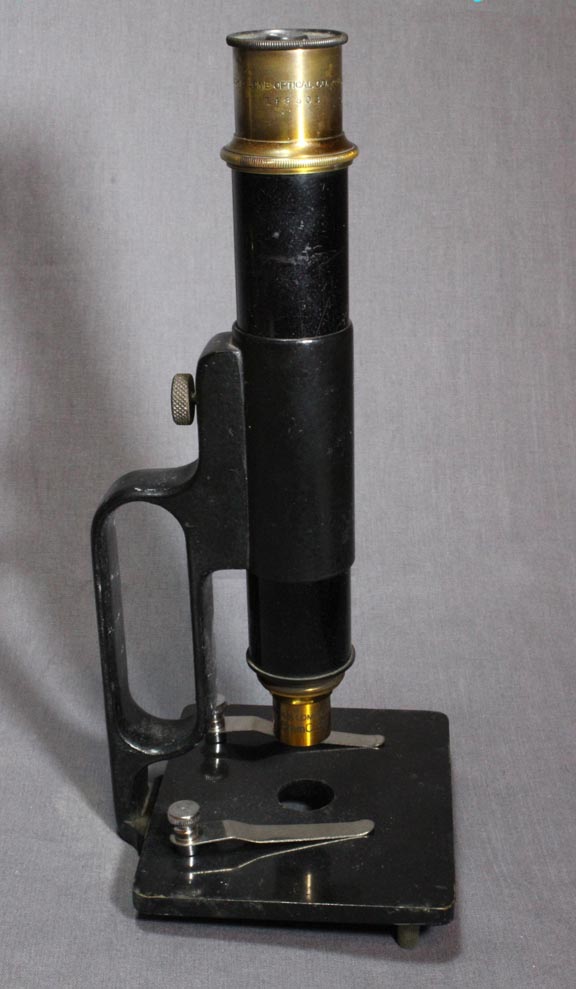 Signed on the top of the optical tube: 'BAUSCH & LOMB OPTICAL CO. ROCHESTER N.Y., 148503', this nearly 100 year old demonstration microscope from about 1921 lacks a substage. The eyepiece is labeled '15X' and the objective is signed: 'BAUSCH & LOMB OPTICAL CO. ROCHESTER N.Y. U.S.A., 16mm 0.25 10X' . The optical tube is focused by sliding within its sleeve lined with cloth. A diamond-knurled knob on the back side pushes on the cloth lining to lock the tube in any desired focus.
Signed on the top of the optical tube: 'BAUSCH & LOMB OPTICAL CO. ROCHESTER N.Y., 148503', this nearly 100 year old demonstration microscope from about 1921 lacks a substage. The eyepiece is labeled '15X' and the objective is signed: 'BAUSCH & LOMB OPTICAL CO. ROCHESTER N.Y. U.S.A., 16mm 0.25 10X' . The optical tube is focused by sliding within its sleeve lined with cloth. A diamond-knurled knob on the back side pushes on the cloth lining to lock the tube in any desired focus.
Demonstration microscopes were soon sold by many different companies in one form or another. Such instruments were made or sold not only by those mentioned above, but also by Charles Collins, Sidle, Spencer, and others. Some like Engell's original model, were strictly handheld demonstration instruments. Others, including variations of Engell's instrument, were convertible from a portable to a handheld demonstration instument and vice versa. When I first decided to create a page about demonstration microscopes, I had no idea that there was such a great variety of types and styles made by so many different companies. I am certain I have not covered all of them. We are grateful to Michael Dingley for providing references to many examples in his CD Catalog of Portable Microscopes (2002), and to my fellow collectors who allowed me to use their images of their own examples.

 The 'demonstration' or 'school' or 'hand' or 'salon' microscope is a portable microscope which can be passed from person to person for the purpose of viewing the same specimen. Although instruments marketed specifically for this purpose were sold from the middle of the nineteenth century, even Leuwoenhoek's microscopes would qualify as this kind of instrument. In fact, Leuwoenhoek sent microscopes with specimens semi-permanently fixed to them to others just to illustrate his conclusions. He was likely one of the first to do this. Similarly, the Screw Barrel microscope was easily passed from person to person and could be used for this purpose. The microscope shown to the left, from the 1700's, would clearly qualify as a 'Demonstration Microscope' though apparently not marketed as such. This web page discusses many brands and variations of these Demonstration, Classroom or Salon Microscopes. It would be nearly impossible to cover them all, so we have concentrated on the most common examples and some more unusual types, as well as those in our own collections and those of other collectors kind enough to let us use their images.
The 'demonstration' or 'school' or 'hand' or 'salon' microscope is a portable microscope which can be passed from person to person for the purpose of viewing the same specimen. Although instruments marketed specifically for this purpose were sold from the middle of the nineteenth century, even Leuwoenhoek's microscopes would qualify as this kind of instrument. In fact, Leuwoenhoek sent microscopes with specimens semi-permanently fixed to them to others just to illustrate his conclusions. He was likely one of the first to do this. Similarly, the Screw Barrel microscope was easily passed from person to person and could be used for this purpose. The microscope shown to the left, from the 1700's, would clearly qualify as a 'Demonstration Microscope' though apparently not marketed as such. This web page discusses many brands and variations of these Demonstration, Classroom or Salon Microscopes. It would be nearly impossible to cover them all, so we have concentrated on the most common examples and some more unusual types, as well as those in our own collections and those of other collectors kind enough to let us use their images.


 Microscopes specifically marketed for the purpose of being a school or demonstration microscope can be traced to no later than the 1860's. Among the earliest was that invented by the Swiss citizen Conrad von Rappard, which was made by his company, Engell & Company, and subsequently distributed by Schaeffer & Budenberg in Germany. Variations included both a smaller version to accept small slides. as well as the larger one to accept standard 1 x 3 inch slides. These were initially only usable as a handheld instrument, but they were soon marketed with a base to replace the demonstration slide holder so that the instrument could also be used as a portable table microscope. These convertible versions had a fine focus added, in addition to the standard sliding coarse focus. Although the inventor was von Rappard, it is commonly referred to as an 'Engell' microscope. After both Engell & Company and Schaeffer & Budenberg, ceased operations in the 1880's, the production of the Engell Microscope was apparently taken over by Paul Waechter, also in Germany. Sometimes these are referred to as Waechter types, but they were not invented by Waechter. These were exported from Germany and sold in the U.S.A. by Queen & Company with their own signature. Most signed by Queen were likely made by Waechter. Waechter called it their 'Demonstration, School and Salon Microscope' and they numbered it as their 'Stand VIII.'
Microscopes specifically marketed for the purpose of being a school or demonstration microscope can be traced to no later than the 1860's. Among the earliest was that invented by the Swiss citizen Conrad von Rappard, which was made by his company, Engell & Company, and subsequently distributed by Schaeffer & Budenberg in Germany. Variations included both a smaller version to accept small slides. as well as the larger one to accept standard 1 x 3 inch slides. These were initially only usable as a handheld instrument, but they were soon marketed with a base to replace the demonstration slide holder so that the instrument could also be used as a portable table microscope. These convertible versions had a fine focus added, in addition to the standard sliding coarse focus. Although the inventor was von Rappard, it is commonly referred to as an 'Engell' microscope. After both Engell & Company and Schaeffer & Budenberg, ceased operations in the 1880's, the production of the Engell Microscope was apparently taken over by Paul Waechter, also in Germany. Sometimes these are referred to as Waechter types, but they were not invented by Waechter. These were exported from Germany and sold in the U.S.A. by Queen & Company with their own signature. Most signed by Queen were likely made by Waechter. Waechter called it their 'Demonstration, School and Salon Microscope' and they numbered it as their 'Stand VIII.'
 Another form marketed as a demonstration microscope was invented by Lionel Beale, also about 1860. One of the earliest forms was sold by William Mathews in England. Its coarse focus was fixed by a system of a sprung peg fitting into holes. According to Dr Beale, various 'improved' forms of it were sold by Baker, Moginie, Hawksley, and Swift. Most of these had a locking ring to fix the coarse focus, though there were some made without a locking mechanism.
Another form marketed as a demonstration microscope was invented by Lionel Beale, also about 1860. One of the earliest forms was sold by William Mathews in England. Its coarse focus was fixed by a system of a sprung peg fitting into holes. According to Dr Beale, various 'improved' forms of it were sold by Baker, Moginie, Hawksley, and Swift. Most of these had a locking ring to fix the coarse focus, though there were some made without a locking mechanism.

 When held alone, the Beale microscope was sometimes called the 'Beale Clinical Microscope'. A variation with the microscope fixed in the horizontal position on a wood base with kerosene lamp at the end of the base was marketed specifically as the 'Beale Demonstration Microscope'. The earlier form(left) had an attachement of the microscope to the base by brass catches. The 'improved model' by Highley(right) was more robust with the microscope attached to the base in a much more secure fashion.
When held alone, the Beale microscope was sometimes called the 'Beale Clinical Microscope'. A variation with the microscope fixed in the horizontal position on a wood base with kerosene lamp at the end of the base was marketed specifically as the 'Beale Demonstration Microscope'. The earlier form(left) had an attachement of the microscope to the base by brass catches. The 'improved model' by Highley(right) was more robust with the microscope attached to the base in a much more secure fashion.  Oliver Wendall Holmes Sr, the father of the famous Judge, was a famous American physician, poet, and inventor in his own right. He designed a modification of the horizontally-oriented Beale demonstration microscope with an inclined body and tilting stage fine focus. This instrument, made by Beck, and referred to in the 1882 Beck catalog as the 'Holmes Lecture Room Microscope' improved its convenience in use, and allowed it to be used easily even while it was placed on a table or desk. The tilting stage fine focus was controlled by a lever attached to a screw and opposed by a spring to prevent any play in the mechanism. This microscope was described and pictured in the JRMS of 1881. An example said to Holmes own instrument, made by R & J Beck, can be seen at the Harvard collection.
Oliver Wendall Holmes Sr, the father of the famous Judge, was a famous American physician, poet, and inventor in his own right. He designed a modification of the horizontally-oriented Beale demonstration microscope with an inclined body and tilting stage fine focus. This instrument, made by Beck, and referred to in the 1882 Beck catalog as the 'Holmes Lecture Room Microscope' improved its convenience in use, and allowed it to be used easily even while it was placed on a table or desk. The tilting stage fine focus was controlled by a lever attached to a screw and opposed by a spring to prevent any play in the mechanism. This microscope was described and pictured in the JRMS of 1881. An example said to Holmes own instrument, made by R & J Beck, can be seen at the Harvard collection.
 Parkes 'Class Microscope' was reported in the 1882 volume of the JRMS, but was listed in the Parkes catalog as early as 1862.. It makes use of the simple but sound concept of an optical bench were all components are mounted on a straight wooden limb. It would be used as a small portable microscope support on a table as shown with a mirror instead of the usual condenser used for demonstration purposes.
Parkes 'Class Microscope' was reported in the 1882 volume of the JRMS, but was listed in the Parkes catalog as early as 1862.. It makes use of the simple but sound concept of an optical bench were all components are mounted on a straight wooden limb. It would be used as a small portable microscope support on a table as shown with a mirror instead of the usual condenser used for demonstration purposes.
 This is Murray & Heath's version of a Classroom Demonstration Microscope, as illustrated in Foster's Report of 1867. It allows the locking of the coarse focus, with fine focus achieved by a secondary draw tube. Note the substage condenser, and the built-in miniature illumination lamp.
This is Murray & Heath's version of a Classroom Demonstration Microscope, as illustrated in Foster's Report of 1867. It allows the locking of the coarse focus, with fine focus achieved by a secondary draw tube. Note the substage condenser, and the built-in miniature illumination lamp.  Also reported in Foster's Report of 1867, this is 'Dr Lawson's' design for a demonstration and table-top portable microscope as made by Charles Collins starting from, or before, 1867. It featured sliding tube coarse focusing and short lever fine focusing from the nosepiece. It detached from its base for handheld use and apparently also had provision for a miniature lamp as a light source. The limb serves as its handle.
Also reported in Foster's Report of 1867, this is 'Dr Lawson's' design for a demonstration and table-top portable microscope as made by Charles Collins starting from, or before, 1867. It featured sliding tube coarse focusing and short lever fine focusing from the nosepiece. It detached from its base for handheld use and apparently also had provision for a miniature lamp as a light source. The limb serves as its handle.

 Nachet of Paris made demonstration microscopes starting about 1872, and their first model, 'Microscope de demonstation a la main' was easily converted from a lightweight portable model to a handheld demonstation model and vice-versa by simply fitting onto a simple stand made for the purpose. It was first reported in the JRMS in 1879. This model was pictured in catalogs through 1892. It is curious that despite being offered for at least 20 years, this model is seldom seen today; one explanation may be that it is constructed with rather thin parts, which although made it conveniently light, meant it would probably not stand up well to repeated use in a classroom. There was apparently no demonstration microscope shown in Nachet catalogs after 1892 until 1910 when a new model was apparently first introduced. This new model was the 'Microscope a main pour demonstration dans les cours' and was a much more substantial continental model which could be detached from its upright on the horseshoe foot(see entry below).
Nachet of Paris made demonstration microscopes starting about 1872, and their first model, 'Microscope de demonstation a la main' was easily converted from a lightweight portable model to a handheld demonstation model and vice-versa by simply fitting onto a simple stand made for the purpose. It was first reported in the JRMS in 1879. This model was pictured in catalogs through 1892. It is curious that despite being offered for at least 20 years, this model is seldom seen today; one explanation may be that it is constructed with rather thin parts, which although made it conveniently light, meant it would probably not stand up well to repeated use in a classroom. There was apparently no demonstration microscope shown in Nachet catalogs after 1892 until 1910 when a new model was apparently first introduced. This new model was the 'Microscope a main pour demonstration dans les cours' and was a much more substantial continental model which could be detached from its upright on the horseshoe foot(see entry below).  The microscope shown here, available no later than 1882, was invented by the Parisian professor A. Guillemare. Its distinctive features included locking screws for the focus of the optical tube and also the slide, providing a more reliable way of illustrating a specific feature of a specimen. It was also provided with the convenience of a built-in stand.
The microscope shown here, available no later than 1882, was invented by the Parisian professor A. Guillemare. Its distinctive features included locking screws for the focus of the optical tube and also the slide, providing a more reliable way of illustrating a specific feature of a specimen. It was also provided with the convenience of a built-in stand.  The demonstration microscope of Hartnack of 1882 would also stand on its own. It consisted of a frame attached to a drum type base. The base had two improvements over some other examples, namely an adjustible wheel of apertures, and a substage condensing lens.
The demonstration microscope of Hartnack of 1882 would also stand on its own. It consisted of a frame attached to a drum type base. The base had two improvements over some other examples, namely an adjustible wheel of apertures, and a substage condensing lens. 
 Shown to the left is a Reichert Demonstration microscope offered in their catalog as early as 1883 through the 1890s. It predated the very similar Leitz model shown below as illustrated in the JRMS of 1888. This microscope has very short legs under the stage. The image to the right is another Reichert Demo scope bearing an even greater resemblance to the Leitz model.
Shown to the left is a Reichert Demonstration microscope offered in their catalog as early as 1883 through the 1890s. It predated the very similar Leitz model shown below as illustrated in the JRMS of 1888. This microscope has very short legs under the stage. The image to the right is another Reichert Demo scope bearing an even greater resemblance to the Leitz model.
 The Klonne & Muller Demonstration Microscope, described in the JRMS of 1883 provided a locking coarse focus, and a tilting stage fine focus. It incorporated four legs to support it when not in use. Although the RMS article states that the slide was held on the bottom plate by the stage clips, the illustration shows a condenser housing in that location, thus it is unclear how this arrangement could be used, if the description is accurate.
The Klonne & Muller Demonstration Microscope, described in the JRMS of 1883 provided a locking coarse focus, and a tilting stage fine focus. It incorporated four legs to support it when not in use. Although the RMS article states that the slide was held on the bottom plate by the stage clips, the illustration shows a condenser housing in that location, thus it is unclear how this arrangement could be used, if the description is accurate.
 Reported in the JRMS of 1885, Murray & Heath's Class Demonstration microscope, earlier noted in Foster in 1865, now incorporated locking mechanisms to lock the slide in place, lock the slide's position on the stage, lock the inclination joint, and lock the coarse focus. Note the built-in light source, introduced with the 1860s model.
Reported in the JRMS of 1885, Murray & Heath's Class Demonstration microscope, earlier noted in Foster in 1865, now incorporated locking mechanisms to lock the slide in place, lock the slide's position on the stage, lock the inclination joint, and lock the coarse focus. Note the built-in light source, introduced with the 1860s model.
 The Winkel Demonstration microscope of 1885 had the advantage of a simple under-the-stage mechanism to readily reposition the slide.
The Winkel Demonstration microscope of 1885 had the advantage of a simple under-the-stage mechanism to readily reposition the slide.
 The famous Robert B. Tolles produced this simplified demonstration microscope which was reported in the JRMS of 1885. Coarse focus was by sliding the inner tube and fine by twisting the entire optical tube assembly.
The famous Robert B. Tolles produced this simplified demonstration microscope which was reported in the JRMS of 1885. Coarse focus was by sliding the inner tube and fine by twisting the entire optical tube assembly.
 The Nelson Portable and Field microscope, otherwise known as the 'Jubilee' Microscope, was made by Powell & Lealand to the design of E.M. Nelson and first reported in late 1887 in the JRMS. Like the Nachet model it was designed as a portable desk top model or as a field or demonstration microscope. Just like the Nachet, after being detached from its stand, a wooden handle would be screwed on to convert it to the demonstration mode.
The Nelson Portable and Field microscope, otherwise known as the 'Jubilee' Microscope, was made by Powell & Lealand to the design of E.M. Nelson and first reported in late 1887 in the JRMS. Like the Nachet model it was designed as a portable desk top model or as a field or demonstration microscope. Just like the Nachet, after being detached from its stand, a wooden handle would be screwed on to convert it to the demonstration mode. The German firm of Ernst Leitz produced several variations of demonstration microscopes over the years. Their model reported in the JRMS of 1888 was apparently a copy of the earlier Reichert version, and simply consisted of a flat stage with two supports to the sleeve for the sliding focus optical tube.
The German firm of Ernst Leitz produced several variations of demonstration microscopes over the years. Their model reported in the JRMS of 1888 was apparently a copy of the earlier Reichert version, and simply consisted of a flat stage with two supports to the sleeve for the sliding focus optical tube.
 This basic form of Zeiss 'Hand Microscope' was offered in the Zeiss catalogs from no later than 1893 through at least 1913.
This basic form of Zeiss 'Hand Microscope' was offered in the Zeiss catalogs from no later than 1893 through at least 1913.  This Zeiss 'Hand microscope' provides an extension of the stage with a frame to hold a comparison image of the subject seen on the slide. It is almost identical to the Reichert version reported in the JRMS of 1893, so likely a copy of the Reichert original. The only difference is that the pieces supporting the microscope tube are in front and back in this one, vs right and left on the Reichert model.
This Zeiss 'Hand microscope' provides an extension of the stage with a frame to hold a comparison image of the subject seen on the slide. It is almost identical to the Reichert version reported in the JRMS of 1893, so likely a copy of the Reichert original. The only difference is that the pieces supporting the microscope tube are in front and back in this one, vs right and left on the Reichert model.
 By 1896, Leitz's Demonstration microscope was offered with a substage wheel of apertures, a 'clip to hold a sketch or label', and a clamp to fix the coarse focus, all standard. Options included fine focus and substage condenser.
By 1896, Leitz's Demonstration microscope was offered with a substage wheel of apertures, a 'clip to hold a sketch or label', and a clamp to fix the coarse focus, all standard. Options included fine focus and substage condenser.
 This is an illustration of the 1903 Kolkowitz Demonstration Microscope as made by Otto Himler of Germany. Note that this microscope also has provision for attaching a matching illustration to assist the user in identifying what they were seeing under the microscope, and that it is shown with a substage condenser.
This is an illustration of the 1903 Kolkowitz Demonstration Microscope as made by Otto Himler of Germany. Note that this microscope also has provision for attaching a matching illustration to assist the user in identifying what they were seeing under the microscope, and that it is shown with a substage condenser.
 This microscope by Koritska from about 1903, has an hourglass-shaped plate mounted above the square stage with space between the top of the stage and the bottom of this plate to accomodate a slide held in place by two stage clips. Focusing is via a twisting pin in groove mechanism.
This microscope by Koritska from about 1903, has an hourglass-shaped plate mounted above the square stage with space between the top of the stage and the bottom of this plate to accomodate a slide held in place by two stage clips. Focusing is via a twisting pin in groove mechanism.

 Bausch & Lomb apparently started to manufacture demonstration microscopes about 1895 and these evolved over the years. The early models, as shown by the 1896 model, were similar to the 1889 model of Zeiss(and others) in that it was simply a focusing tube attached to a plate supporting a slide. By 1904 a handle was added, and by 1911 it looked more like a microscope with a 'jug handle'. Variations of the jug handle continued through at least 1922. The only drawback still present in the 1922 model, was that the slide was held in place by stage clips and so as it was passed from student to student, the slide was likely to move unless taped in place.
Bausch & Lomb apparently started to manufacture demonstration microscopes about 1895 and these evolved over the years. The early models, as shown by the 1896 model, were similar to the 1889 model of Zeiss(and others) in that it was simply a focusing tube attached to a plate supporting a slide. By 1904 a handle was added, and by 1911 it looked more like a microscope with a 'jug handle'. Variations of the jug handle continued through at least 1922. The only drawback still present in the 1922 model, was that the slide was held in place by stage clips and so as it was passed from student to student, the slide was likely to move unless taped in place.
 The 'Microscope a main pour demonstration dans les cours,' first introduced in the 1910 Nachet catalog, was a portable continental model which could easily and quickly be detached from its upright on the horseshoe foot, and held by its limb, becomming a demonstration microscope. This idea of detaching from the upright of the foot at the level of the stage was not invented by Nachet, having been developed by Sidle and others, many years earlier. As noted above this is a much more rigid stand, likely to stand up to more use than the prior Nachet demonstration model.
The 'Microscope a main pour demonstration dans les cours,' first introduced in the 1910 Nachet catalog, was a portable continental model which could easily and quickly be detached from its upright on the horseshoe foot, and held by its limb, becomming a demonstration microscope. This idea of detaching from the upright of the foot at the level of the stage was not invented by Nachet, having been developed by Sidle and others, many years earlier. As noted above this is a much more rigid stand, likely to stand up to more use than the prior Nachet demonstration model.
 Signed on the top of the optical tube: 'BAUSCH & LOMB OPTICAL CO. ROCHESTER N.Y., 148503', this nearly 100 year old demonstration microscope from about 1921 lacks a substage. The eyepiece is labeled '15X' and the objective is signed: 'BAUSCH & LOMB OPTICAL CO. ROCHESTER N.Y. U.S.A., 16mm 0.25 10X' . The optical tube is focused by sliding within its sleeve lined with cloth. A diamond-knurled knob on the back side pushes on the cloth lining to lock the tube in any desired focus.
Signed on the top of the optical tube: 'BAUSCH & LOMB OPTICAL CO. ROCHESTER N.Y., 148503', this nearly 100 year old demonstration microscope from about 1921 lacks a substage. The eyepiece is labeled '15X' and the objective is signed: 'BAUSCH & LOMB OPTICAL CO. ROCHESTER N.Y. U.S.A., 16mm 0.25 10X' . The optical tube is focused by sliding within its sleeve lined with cloth. A diamond-knurled knob on the back side pushes on the cloth lining to lock the tube in any desired focus.